June 28, 2017
The Honourable Ralph Goodale
Minister of Public Safety
House of Commons
Ottawa, Ontario
Dear Minister,
In accordance with section 192 of the Corrections and Conditional Release Act , it is my privilege and duty to submit to you the 44 th Annual Report of the Correctional Investigator.
Yours respectfully,
Ivan Zinger, J.D., Ph.D.
Correctional Investigator
Table of Contents
Correctional Investigators Message
1. Health Care in Federal Corrections
2. Prevention of Deaths in Custody
5. Safe and Timely Reintegration
Special Focus on Secure Units at Regional Womens Facilities
Correctional Investigators Outlook for 2017-18
Ed McIssac Human Rights in Corrections Award
Annex A: Summary of Recommendations
Correctional Investigators Message
This is my first Annual Report since being appointed Correctional Investigator in January 2017. Since taking up office, I have made a point to travel to each of the Correctional Service of Canadas (CSC) five regions to meet with staff and visit as many institutions as time away from the Office would allow. Though I previously served as Director of Policy and Senior Counsel then Executive Director and General Counsel for over ten years, my new responsibilities afforded me the opportunity to take a closer and renewed measure of life behind bars in Canada today. What I observed and experienced have enriched and deepened my conversations and engagement with CSC staff and senior level management alike. I have witnessed anew the potential and promise of corrections along with its harsher and bleaker aspects. In my experience, these two sides co-exist wherever and whenever people are deprived of their liberty. As I assume my new duties, I approach the many challenges, demands and expectations of this job as letting more of the light shine through.

Ivan Zinger
Correctional Investigator of Canada
Though I have experienced and learned much in my first few months on the job, there is little doubt that I am still finding my voice as I work my way through the issues that were so adeptly handled by my predecessor, Mr. Howard Sapers. Personally and professionally, the learning curve has been steep, but I have been well-mentored. Appointed several times by different governments, Howard served 12 years as Correctional Investigator from April 2004 to December 2016. His leadership, vision and profile consolidated and advanced the Offices mandate through some difficult issues and some equally challenging times. Howard raised and championed issues of national prominence and concern, such as mental health and corrections, prevention of deaths in custody, safe and humane custody, Indigenous and women offenders. His indelible imprint continues to influence and inspire our work. Indeed, many of the issues and priorities developed in this report were in fact initiated under Howards leadership, though the findings and recommendations are my own.
Transitions are never easy affairs. I am fortunate to be assisted by the same management team, though some have taken on more demanding assignments in more senior roles. I grow more confident in my position each and every day thanks to their invaluable support, advice and guidance. I appreciated the efforts of all staff in maintaining a business as usual approach through a period of considerable and lengthy uncertainty that surrounded the appointment of Howards successor.
Even with changes in senior leadership, the Offices purpose and function remains the same: to serve as an Ombudsman for federally sentenced offenders and to investigate offender complaints, individually and as a group, related to decisions, recommendations, acts or omissions of the Correctional Service. The Offices priorities have not changed, though there may be some nuances in how they are pursued and presented under my direction. The mandate of the Correctional Investigator is to investigate individual offender and systemic issues in federal corrections and make recommendations to ensure safe, lawful and humane custody.
This mandate, I believe, can only be achieved through recognition that corrections is in the human rights business. Every aspect of a prisoners life from whether or when they have visits or calls with family and friends to whether and how they may practice their religion, and even what, when, where or how much they eat and when they rest, sleep, socialize or exercise is highly regulated, subject to the power, control and discretion of correctional authorities. Understandably, lack of control and autonomy over how the most basic necessities of life are met can be a considerable source of frustration and anxiety for prisoners. Security classification, penitentiary placement, use of force, search and seizure, transfer and segregation placements all have significant life and liberty implications for people behind bars. Under such conditions, prisoners require means and access to an independent body to bring forward and resolve legitimate complaints and grievances, in confidence, and without fear of reprisal. If corrections is first and foremost a human rights endeavour, then the protection, promotion and preservation of human dignity and decency behind bars continues to require vigilance.
My first annual report is purposefully illustrated with many visual reminders from my recent visits to institutions across the country. Given every picture tells a story and is worth a thousand words, then this report promises to be briefer and perhaps more visually arresting than in previous years. True to form, at every institution that I visited the promise and predicament of corrections was prominently on display. While I saw some excellent examples of offenders productively engaged in prison industries, I also observed too many other instances where they were either unemployed or underemployed or not participating in any educational, vocational or correctional programming. Time spent in cellular confinement seemed particularly unreasonable in many of the enhanced supervision or structured living units that I visited. The proliferation of these units seems to be an unintended consequence of the effort and priority given to reduce segregation admissions and length of stay. However, as is so often the case in corrections, just as one problem appears solved, another is created.
At Edmonton Institution, I witnessed outdoor segregation yards that were actually cages, easily mistaken for a dog run or kennel. I was told that these so-called yards were built at a time when segregation numbers were double what they are today. Due to incompatibles, rival gangs and population pressures, some segregated inmates were not able to get their required hour of outdoor yard time in association with others. The individual yards were put into service as a population management measure and to (minimally) meet a legal entitlement. Going forward, I can see no redeeming value or purpose in continuing their use. At that same institution, the Office had earlier investigated a series of policy violations, allegations of mistreatment of offenders and potential human rights abuses which seemed to originate from a dysfunctional and toxic workplace. While labour management relations do not fall under the purview of my Office, I am often compelled to investigate when problematic elements of organizational culture generate adverse impacts for those under CSCs care and custody. Rehabilitation and reintegration cannot be accomplished in a workplace that tolerates a culture of indifference or impunity. I am encouraged by CSCs efforts to address the toxic workplace environment at Edmonton Institution, including moving forward on implementing recommendations of an independent report commissioned by the Service. I am hopeful that the work environment of staff and living conditions of prisoners will improve as a result.
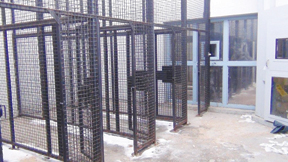
Photo of outdoor segregation yard at Edmonton Institution.
On other visits, I walked through many featureless and uninviting outdoor exercise yards predictably and uniformly covered in asphalt or concrete. At a medium security facility in British Columbia I sat scrunched and stooped in the back of a prison transport van, the insert of which is completely outfitted in aluminum and stainless steel hardware. The compartment where shackled prisoners are kept to take them to attend court or medical appointments is totally devoid of any comfort or safety feature, including seatbelts. The experience left me feeling as if personal safety and human dignity did not matter to the designers or operators of such vehicles.
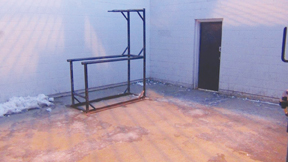
Photo of outdoor "exercise" yard showing concrete walls and metal bars.
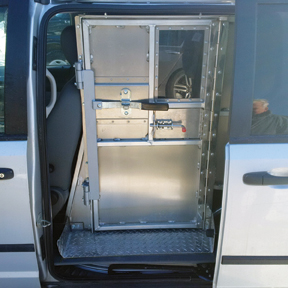
Photo of metal door of inmate transport van.
I observed segregation and isolation units and even cells on regular living areas that had no source of natural light or manual ventilation. Stainless steel toilets and sinks bolted to the floor and other permanently fixed furnishings dominate cellular interiors at most penitentiaries, creating an unnecessarily stark and foreboding environment for human habitation. At one institution, the door to the segregation cell was inexplicably covered over in plastic safety glass. When I asked why, staff could not form a cogent defense or reason that did not default to some undefined but ubiquitous security concern of one kind or another. As is so often seen in corrections, the extraordinary case becomes the response upon which all other future actions are mediated. Once implemented it is rare for a temporary security measure to be removed or lowered: it simply becomes the new standard.
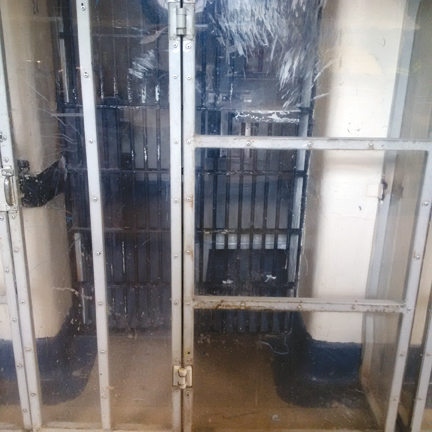
Segregation cell covered over in plastic safety glass
I also made a point to visit Saskatchewan Penitentiary in Prince Albert where a full-scale riot in December 2016 in the medium security sector left one inmate murdered, another seriously assaulted and several others requiring hospitalization for shotgun wounds. The ensuing rampage and destruction of government property rendered many of the living units uninhabitable. In search of some other plausible explanation for the incomprehensible violence and mayhem beyond bad or inadequate food, I noted that some of the cells in that forbidding and antiquated facility housed two inmates even though there is barely adequate space for one. Standing in the middle of another cell, I could reach out and touch the sides of both walls. Long after the rage of the riot had been quelled, a palpable sense of tension lingers in that facility. I could not help but notice that the overwhelming majority of its occupants are young, desperate Indigenous men. To my mind, the year-on-year increase in the over-representation of Indigenous people in Canadian jails and prisons is among this countrys most pressing social justice and human rights issues.
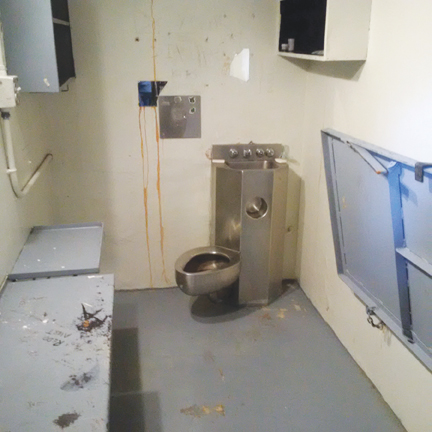
"Uninhabitable" living unit after riot
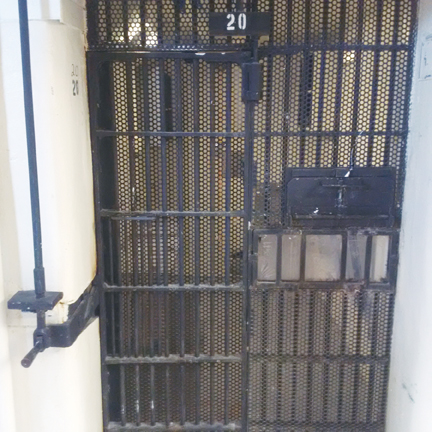
Standing in the middle of the cell I could reach out and touch both sides of both walls.
One can imagine the sense of futility and despair such environments and conditions of confinement elicit from people who are often mentally unwell, or whose lives have been touched or marked by some combination of alcohol or drug addiction, family dysfunction, discrimination, poverty, childhood violence, abuse or trauma. Elevated rates of prison self-injury and suicide, high prevalence of mental illness and premature natural mortality behind bars speak to the unremittingly high costs of imprisonment for some of Canadas more vulnerable populations.
Beyond these initial observations and reactions, one of my first orders of business is to find a way to reduce the volume of contacts and complaints brought forward to my Office involving relatively minor matters. While I understand and appreciate that small things mean a lot to prisoners, the capacity of the Correctional Service to respond to everyday inmate requests in a timely and appropriate manner is a source of constant but unnecessary frustration for inmates and an increasingly serious point of contention with my Office. Even relatively routine requests affecting living conditions and institutional routines e.g. access to canteen, mail delivery problems, issues related to lost, damaged or confiscated personal effects, meal times, inmate movement, out-of-cell time often extend well beyond the 15-day period which the correctional authority grants itself to respond, or they simply go unanswered altogether. In some facilities, there appears to be no standard process for tracking or monitoring comparatively simple requests from inmates.
To the point of the matter, too much of my investigators time during regular institutional visits is taken up intervening or resolving issues or complaints that should have been addressed through internal systems. Straightforward issues are most properly dealt with at source, not routinely escalated to my Office. Even as my Office takes steps to address founded complaints through better triage at intake and early resolution, there appears to be no end to the issues that quite properly belong with or have been created by CSC maladministration. Common examples include: tracking down an inmate request that has not been answered or dealt with appropriately; inquiring about an unreasonably delayed response to an inmate complaint filed at the institutional level; following-up on an overdue security or pay level review; issuing reminders about pending applications for a family visit, work release or temporary absence. All of these seem an unnecessary and redundant burden on staff time and resources. Effort invested to resolve these and other matters impacts on the Offices ability to address more systemic or emergency matters, such as transfers, access to medical care or segregation. I believe that, with some changes to policy and practice within CSC and my Office, service improvements can be made to the mutual benefit of all parties.
I will conclude by drawing attention to some of the major investigations and systemic reviews completed during the reporting period. The Office conducted two major investigations. In the Dark: An Investigation of Death in Custody Information Sharing and Disclosure Practices in Federal Corrections was released as a public interest report on August 2, 2016, and Fatal Response: An Investigation into the Preventable Death of Matthew Ryan Hines was tabled as a Special Report to Parliament on May 2, 2017. An investigation into the experience of young adult offenders in federal custody (age 18 to 21) was initiated mid-year and is ongoing. A comprehensive review of the Secure Units (Maximum Security) at the Regional Womens facilities was also completed, the findings of which are incorporated in this report.
Other major thematic, policy and priority reviews initiated or monitored through the reporting period included the following:
- Timely and appropriate recognition and response to medical emergencies and/or psychological distress.
- Alternatives to incarceration for seriously mentally ill offenders (complex needs).
- Conditions of confinement in administrative segregation.
- Controls and safeguards on the use of chemical and inflammatory sprays in use of force interventions.
- Adequacy and appropriateness of the CSC investigating and disciplining itself.
- Embedding gender identity and gender expression in federal correctional practice and policy.
- Implications of Medical Assistance in Dying legislation for federal corrections.
- Components of an integrated and comprehensive national older/aging offender strategy (age 50 and older).
This report serves as a summary of the collective output of a small but extraordinarily talented and dedicated team of professionals. As the newly appointed Correctional Investigator, I am proud to lead and represent their work in my first Annual Report to Parliament.
Ivan Zinger, J.D.,
.D.
Correctional Investigator
June 2017
1. Health Care in Federal Corrections
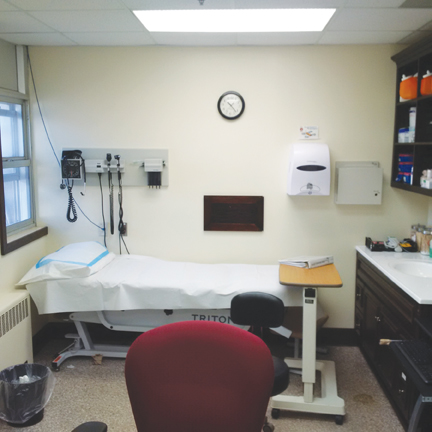
Photo of health care room at a federal penitentiary.
Issues in Focus
United Nations Standard Minimum Rules for the Treatment of Prisoners (the Nelson Mandela Rules)
The provision of health care for prisoners is a State responsibility. Prisoners should enjoy the same standards of health care that are available in the community. (Rule 24)
All prisons shall ensure prompt access to medical attention in urgent cases. Prisoners who require specialized treatment or surgery shall be transferred to specialized institutions or to civil hospitals. (Rule 27 (1))
Clinical decisions may only be taken by the responsible health-care professionals and may not be overruled or ignored by non-medical prison staff. (Rule 27 (2))
The relationship between the physician or other health-care professionals and the prisoners shall be governed by the same ethical and professional standards as those applicable to patients in the community. (Rule 32 (1))
Health-care personnel shall not have any role in the imposition of disciplinary sanctions or other restrictive measures. (Rule 46)
The Mandela Rules Footnote 1 and the Role of Health Care Services and Health Care Providers
The role of medical staff in prison, as in the community, is to protect, promote and provide for the care of their patients, who also happen to be prisoners. The same ethical and professional standards of health care practice informed consent, patient autonomy, confidentiality apply in prison as in the community. I n carrying out their duties, the Mandela Rules instruct that correctional health care workers must be provided full clinical and professional independence. Clinical decisions may only be taken by health care professionals; the prison administration must not influence, interfere with or go against the decisions of the health care team. Health care staff must never be involved in assessing fitness for, approving or inflicting disciplinary punishments. Footnote 2
As concerning as the unauthorized and illegal body cavity search case is it is not the only example where dual loyalties can create ethical dilemmas and role conflicts for correctional health care providers. CSC segregation policy, for example, requires health care professionals to conduct mental health assessments of inmates and to be part of the review body that determines whether or not a prisoner should remain in administrative segregation (solitary confinement). Under the newly revised Mandela Rules , not only should health care staff not be involved in imposition of disciplinary sanctions or other restrictive measures, they have an additional positive obligation to report to the director, without delay, any adverse effect of disciplinary sanctions or other restrictive measures on the physical or mental health of a prisoner subjected to such sanctions or measures and shall advise the director if they consider it necessary to terminate or alter them for physical or mental health reasons (Rule 46 (2)).
Issues in Focus
Unauthorized and Illegal Body Cavity Search
- A body cavity search is an extremely invasive procedure that requires, by law, the highest degree of compliance with procedural safeguards.
- The Office received a complaint from an inmate that a body cavity search had been performed on him during a lockdown and search for a handgun that was suspected to have been brought into the institution. Suspicion initially and throughout the lockdown period focused primarily on this one inmate.
- He was strip searched five times over an 8-day period. Since the suspected weapon could not be located during the search, the Warden authorized an x-ray search of the inmate. Three x-rays were taken and all were clean.
- Following the x-ray searches, the institutional doctor asked the inmate to perform a body cavity search, purportedly to ensure he was not concealing anything. Although the inmate verbally consented to the procedure (reluctantly as he clearly felt intimidated and coerced to comply), the search itself was conducted in violation of several sections of the Corrections and Conditional Release Act . Specifically:
- The Warden had not authorized the body cavity search.
- The offenders written consent was not obtained.
- He was not offered the opportunity to contact legal counsel.
- In this case, the body cavity search was performed entirely for security and not medical reasons. It did not seem to be absolutely necessary given that the x-ray exams had already revealed nothing was being concealed. There were no reasonable grounds to believe that a handgun was concealed after the x-rays were taken a legal requirement to authorize a body cavity search.
- CSC agreed with the Offices recommendation to refer the case for review to the appropriate provincial regulatory body, and, also at the insistence of the Office, a CSC National Board of Investigation was convened.
Moreover, the Rules direct that the imposition of solitary confinement should be prohibited in the case of prisoners with mental or physical disabilities when their conditions would be exacerbated by such measures (Rule 45 (2)). The Rules recognize that forging or maintaining therapeutic relationships is difficult, if not impossible, when clinicians are asked to be part of potentially harmful correctional practice. Finally, though both policy and legislation still allow for indefinite or prolonged confinement in segregation, such practices are prohibited under the revised Mandela Rules.
Management of Inmate Self-Injurious and Suicidal Behaviour
The management of self-injurious and/or suicidal persons in federal custody has long been a concern of this Office. Footnote 3 Despite extensive Office commentary, findings and recommendations going back several years, there remain significant omissions in the use of physical restraints to manage self-injurious and suicidal behaviour in prison. Though the Mandela Rules recognize certain legitimate reasons for using physical restraints in correctional settings, including preventing prisoners from injuring or harming themselves (Rule 47 2(b)), their use is permitted only in narrow and exceptional circumstances in line with principles of legality, necessity and proportionality, and when all other options have been exhausted. For corrections, these principles translate as:
- Physical restraints should only be used if an offender presents an immediate and extreme risk of injury to him/herself or to others.
- Physical restraints should be applied as a last resort and for the shortest period necessary consistent with the preservation of life and least restrictive option.
- Physical restraints should not be used as punishment or retaliation.
- Human dignity should be maintained at all times that an offender is subject to restraint equipment.
Self-Injurious Incidents and Number of Offenders 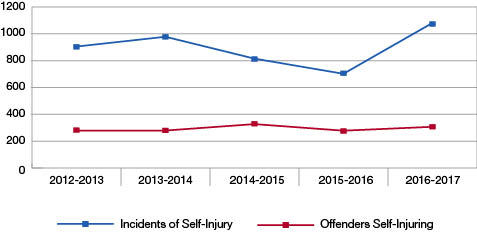
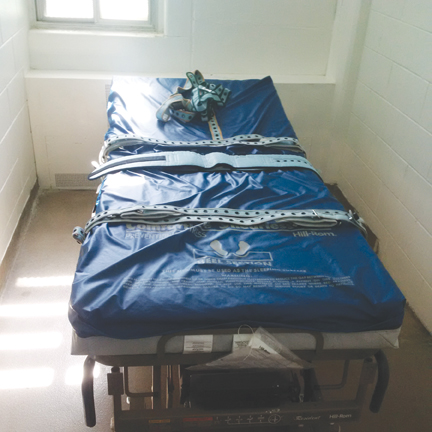
Photo of a Pinel restraint bed.
As defined in CSC health care policy, the Pinel Restraint System (PRS) is a variable-point medical restraint system. Footnote 4 It is the only restraint system authorized to be used for self-injurious behaviour in maximum and medium security institutions, women offender institutions and Regional Treatment Centres. Footnote 5 As a medical device, Footnote 6 it would seem appropriate that its use should be authorized by professional health care staff working in a hospital setting (i.e. Regional Treatment Centres, which are designated Psychiatric Hospitals). To ensure the PRS is used exceptionally, sparingly and only by authorization of a psychiatrist and under the direct supervision of mental health professionals, this device should be available only in designated Treatment Centers. If an inmate in a regular institution cannot be controlled, a psychiatrist or physician can administer emergency medical treatment until such time as a transfer to an outside hospital or Treatment Centre can be initiated. Interventions to preserve life and prevent serious bodily injury may occur in mainstream institutions, but these involve an emergency response to stop an inmate from engaging in further self-injurious behaviour, regardless of whether there was intent to end life. By continuing to make this device available across all security levels rather than limiting its use to CSCs Regional Treatment Centres, the policy effectively normalizes its use in mainstream institutions. It is not consistent with a least restraint principle, a direction that recognizes the potentially harmful effects of using physical or environmental restraint (e.g. seclusion) to manage people in acute psychological distress.
Under current policy, the decision to authorize the application, reduction of use or removal of instruments of restraint to prevent self-injury continues to reside with the Warden, not health care providers. Footnote 7 With respect, this decision properly resides with clinicians. The Office has further recommended that all instances where restraints are applied to prevent self-injury should be considered a reportable use of force. In a correctional setting, the so-called consensual or cooperative use of physical restraints to prevent self-injury does not reflect standards of valid, voluntary and informed consent. Informed consent is a legal/ethical requirement. Further, for accountability purposes, video monitoring of the entire duration of placement in the PRS, including removal of restraints, should be required policy and operational practice.

Health Services - Pinel Restraint Room (medium security)
It is instructive that the policy prescribes that inmates on high suicide/self-injury watch are to be placed in an observation cell that minimally provides the basic necessities to preserve and dignify human life:
a. at minimum, a security gown, at all times
b. a security blanket and mattress, unless the inmate attempts to use these items in a manner that is self-injurious or affects staffs ability to monitor the inmate. In this case, the items can be removed from the cell, with the intention of returning the items as soon as safely practicable
c. the offer of a change of security gown/blanket daily, or as required
d. fluids and food that can be easily consumed without cutlery or tableware (finger foods)
e. hygiene items (the health care professional will determine when to provide hygiene items if these items are associated with any risk for suicidal or self-injurious behaviour and will inform the Duty Correctional Manager).
There seems little recognition that confinement in these conditions may actually promote or deepen psychological distress or lead to further or even more lethal acts of self-harm or attempts to end life. The fact that these stark environments are often viewed as punitive or even damaging for people experiencing significant psychological distress is not acknowledged. There is no requirement for security staff who are assigned constant, direct observation of self-injurious or suicidal inmates to also be a source of human contact, comfort or compassion. Moreover, the policy now allows for an inmate to be kept in these conditions up to 15 days before Regional authorities are informed or engaged in monitoring the case. As with administrative segregation, there is no limit or cap on how long an inmate can actually be kept in a state of clinical seclusion or isolation. This situation, which continues to allow for distressed individuals to be kept in potentially unsafe and harmful conditions of detention indefinitely, speaks to the contradictions between the security and control orientation of this policy direction at the expense of any defensible therapeutic aims.
- I recommend that CSC review, in FY 2017-18, its health care policies, practices and authorities to ensure they are compliant with the revised United Nations Standard Minimum Rules for the Treatment of Prisoners (Nelson Mandela Rules), specifically those relating to health care services (Rules 24 to 35), solitary confinement (Rules 45 and 46) and instruments of restraint (Rules 47 to 49).
Alternatives to Incarceration
The Office continues to call for external psychiatric hospital placements in cases of extremely complex or significant mental illness. These cases continue to arise in mainstream institutions that lack the appropriate capacity, resources and infrastructure to manage serious mental health conditions. The issue is especially problematic in womens corrections as there is no dedicated, stand-alone treatment facility for women in federal corrections. Footnote 8 In the Pacific Region, women in need of emergency health care or hospitalization are temporarily transferred to and housed in a unit at the all-male regional psychiatric facility. Isolated from the other male patients, these mentally ill women are managed in segregation-like conditions not conducive to treatment. This practice systematically discriminates against women struggling with mental health problems; it is totally unacceptable and contrary to international human rights standards, including the Mandela Rules.
- I recommend that transferring mentally ill women in the Pacific Region to the all-male Regional Treatment Centre be absolutely and explicitly prohibited. Women requiring mental health treatment should be transferred to the female unit at the Regional Psychiatric Centre (RPC) in Saskatoon, or, preferably, to a local external community psychiatric hospital as required.
Mental Health Care Funding for Alternatives to Penitentiary
There continues to be inadequate treatment space for significantly mentally ill persons who cannot be safely or humanely managed in a federal correctional facility. This need remains especially acute for federally sentenced women. The CSC needs to create, conclude and fund alternative service agreements and arrangements with provincial and territorial mental health providers that would allow for the transfer and placement of complex needs offenders in community psychiatric facilities. Footnote 9 In recent years, there has been only one agreement concluded: it provides for two beds at the Brockville Mental Health Centre in Ontario. This situation is simply inadequate and unacceptable.
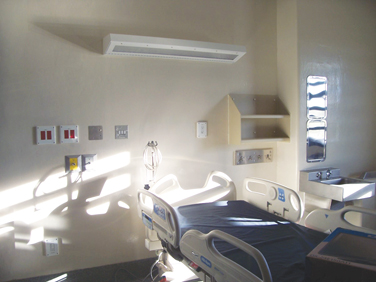
Photo of health care room with medical bed.
My frustration here stems from the fact that CSC could have funded and already created community capacity that would provide the level of care necessary to manage challenging or complex mental health cases. The Ashley Smith inquest, concluded in December 2013, made very specific recommendations to realize such an outcome:
- That female inmates with serious mental health issues and/or self-injurious behaviours serve their federal terms of imprisonment in a federally-operated treatment facility, not a security-focused, prison-like environment.
- That such a facility or facilities be made available at least on a regional basis, and particularly in Ontario.
- That CSC negotiate arrangements with provincial health care facilities to provide long-term treatment to female inmates who chronically engage in self-injurious behavior or display other serious mental health problems. Further:
a) that the Government of Canada sufficiently and sustainably funds the CSC to enter into such agreements;
b)that this will include any and all capital and operating costs associated with the establishment of such facilities, and that the accommodation and treatment of female inmates therein will be the responsibility of CSC.
To come to the point of the matter, even with the recent expansion of intermediate mental health care beds at the regional womens facilities (for a total of 60 beds across the country) there still seems to be better treatment capacity for men in federal corrections. The CSC claims that it is too costly to place and treat significantly mentally ill women in provincial psychiatric facilities, and, further, these facilities are reluctant to accept complex needs cases requiring an acute level of care and/or supervision. These claims do not seem entirely substantiated given that this Office is aware that CSC has received proposals from external psychiatric/forensics facilities that would expand treatment capacity in the community contingent on the Service agreeing to fund the arrangements appropriately based on a higher professional staff to patient ratio (or higher per diem rate). The failure to conclude more federal/provincial exchange of service agreements for community placements based on funding considerations seems particularly problematic and short-sighted, especially if the full range of costs associated with managing acute needs in prison versus forensic settings is considered (e.g. use of force interventions, segregation placements, 24/7 direct observation, etc). Moreover, the risk of managing serial self-injurious and/or suicidal women on an ad-hoc and exceptional basis needs to be balanced against therapeutic not purely funding considerations. The price of not doing so may ultimately be more tragic and preventable deaths in custody and costly civil settlements in wrongful death cases.
- I recommend that CSC issue a Request for Proposal to fund or expand community bed treatment capacity to accommodate up to 12 federally sentenced women requiring an intensive level of mental health intervention, care and supervision.
Gender Identity and Gender Expression Rights in Corrections
In last years Annual Report, the Office recommended that upon request and subject to case-by-case consideration of treatment needs, safety and privacy, transgender or intersex inmates should not be presumptively refused placement in an institution of the gender they identify with. In response, the Service indicated that in fiscal year 2016-17, CSC will initiate a review of its policies to ensure the rights of transgender inmates are protected, including consideration of safety, security and privacy related to placement. This review will be undertaken while CSC closely monitors the progression of proposed legislative changes through Parliament ...
The review and promulgation of CSCs new gender dysphoria policy on January 9, 2017 did not, as it turned out, permit penitentiary placement of transgender prisoners based on gender identity. In fact, just a few days after CSC had promulgated its revised policy direction, Prime Minister Justin Trudeau responding to a question at a town hall gathering, promised that federally sentenced offenders could indeed serve their prison sentences based on their gender identity. A major policy reversal immediately followed the Prime Ministers intervention, with the Minister of Public Safety and CSC announcing that the Service would indeed allow for penitentiary placement of transgender persons based on gender, not genitalia.
Issues in Focus
The Experience of Being Transgender in Federal Custody
- Until recently, a transgender inmate spent most of their sentence (over 10 years) in a facility representing their assigned sex at birth.
- The experience and impact, both physical and emotional, of the lack of recognition of gender identity and gender expression seems beyond comprehension. The inmate documented numerous incidents where they were subjected to crude and offensive comments from CSC staff and inmates, pushed to the side by healthcare staff, refused hormone therapy treatment, refused private showers and denied recognition of a name change.
- Desperation led the inmate to attempt suicide, self-mutilate genitalia and take pills bought from other inmates. The inmate fell into depression as a result of the treatment and lack of movement on the part of CSC with respect to the inmates sex change.
- The offender filed a complaint to the Canadian Human Rights Commission (CHRC) which vividly detailed the experience and treatment of being transgender in a federal correctional institution.
- The inmate died from complications not long after being transferred to an institution representing their gender identity. Though the death is still under investigation and appears unrelated to the inmates gender identity, the family has decided to pursue the human rights complaint on the inmates behalf.
At various points over the reporting period, CSCs approach to this issue has been contradictory, disappointing and frustrating. Following the policy reversal, CSC initiated a major effort to bring the rest of CSCs policy framework admission, classification, searches, use of force, personal property, health services, etc. into line with Bill C-16, which would amend the Canadian Human Rights Act to add gender identity and gender expression to the list of prohibited grounds of discrimination. This bill is expected to become law.
In the context of federal correctional policy and practice, there does not appear to be a very deep understanding or appreciation for what the terms gender identity and gender expression actually mean. Other jurisdictions in Canada, notably British Columbia and Ontario, have for some time now been responsive and inclusive in their approach to ensuring that the rights of transgender, transsexual and other gender non-conforming peoples are respected and protected in custody; in contrast, federal corrections appears mired, if not stuck, in conventional attitudes and assumptions. Legislative change is coming, and CSC needs to embrace it. Unresponsive policy and practice can lead to unimaginable and needless suffering. This must change.
Ontario Correctional Services Policy for the Admission, Classification and Placement of Trans Inmates
Highlights
- Policy recognizes a persons self-identified gender, preferred name and pronouns, as well as their housing preference, unless it can be proven that there are overriding health or safety concerns which cannot be resolved.
- Trans inmates must be given the opportunity to choose who will perform any searches. The inmate is offered privacy in which to be searched, including any searches of prosthetics.
- Information about an inmates gender identity or history will only be shared with those directly involved with their care, and only when relevant.
- Trans inmates are to be integrated into general population, not isolated or segregated.
- Trans inmates must be provided with their preferred institutional clothing and underclothing.
- Trans inmates must be offered individual and private access to the shower and toilet for safety and privacy purposes.
- The policy is supported by a comprehensive staff training and awareness program.
Source: Ontario Correctional Services, January 2015
Harm Reduction Measures in Prison (Safe Tattooing)
Increasingly popular in the larger Canadian society, tattooing is still a prohibited practice in federal institutions. People who engage in tattooing behind bars are forced to conduct their work underground, often sharing and reusing unsterile homemade tattooing equipment. Illicit prison tattooing has been associated with higher rates of blood-borne infections such as Hepatitis C and HIV among the inmate population. Footnote 10 And when there is no safe means of disposal of used needles, the health risks extend beyond inmates, impacting on corrections staff. Between April 1, 2011 and April 1, 2017, there were sixteen incidents where a staff member was accidentally poked by a needle/syringe, primarily as a result of a search. Footnote 11 The Canadian public is also at risk as offenders returning to communities bring with them any infections or health care issues acquired during incarceration.
In 2005, CSC began a pilot program targeted at controlling the spread of infectious disease with the implementation of tattoo rooms in six federal institutions (one mens institution in each of the five regions and one womens institution). Despite an evaluation conducted by CSC indicating that the program had the potential to reduce harm, decrease exposure to health risk and enhance the health and safety of staff members, inmates and the general public, the program was terminated in 2007 by the Conservative government. Also, as CSCs own evaluation demonstrated, the program provided important employment opportunities for inmates while incarcerated and more importantly, marketable skills upon release into the community. While CSC continues to offer bleach as a means of cleaning needles, this measure has been found to have limited effectiveness in preventing the spread of Hepatitis C. Footnote 12 Re-instating the safe tattooing program within federal institutions would not only minimize the risk of transmission of infectious diseases, but it could also save money over the long-term, particularly given the high costs associated with treating HIV and Hepatitis C in prison.
- I recommend that CSC reintroduce safe tattooing as a national program.
Medical Assistance in Dying
Bill C-14, medical assistance in dying (or MAID), became law in Canada on June 17, 2016. In addition to making assisted death available to federally sentenced offenders, the legislation also amends the Corrections and Conditional Release Act to exempt CSC from having to conduct a mortality investigation when an offender receives medical assistance in dying. In the reporting period, the Office received and commented on proposed guidelines for MAID in federal corrections. Though the guidelines have not yet been promulgated, central questions come down to where, when and how best to deliver end of life care to a terminally ill person who is still under correctional supervision. They can be summarized as:
- The decision to seek medical assistance in dying should be made, to the extent possible, while the palliated individual is in the community, preferably on parole by exception status.
- Consideration of the pressures, restrictions and influences that limit an inmate- patients option(s) who is terminally ill to end life at a place and time of their own preference and choice.
- Need for a Patient Advocate to protect inmate patients rights and ensure they fully understand and meet the eligibility criteria of MAID.
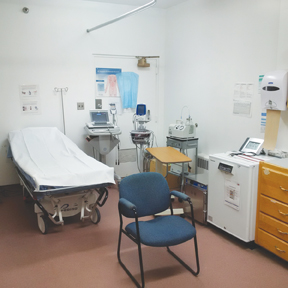
Photo of health care room with medical bed and devices.
Managing palliation in end of life situations within a prison setting is challenging and costly. Unfortunately, it is also an increasingly frequent necessity: in 2016-17, there were 37 deaths in federal custody by natural cause. Although the data on where the offenders died (penitentiary, treatment center or external community hospital), and whether palliative or end of life care was provided are not currently available. Experience indicates that most natural deaths will have been expected and occurred in a federal penitentiary.
In the Offices view, the manner, place and timing of MAID needs to provide as much practical choice as possible in how palliative inmates might otherwise choose to end their life. They should not simply be referred to a community hospital for the procedure. CSC must work with the Parole Board to ensure that palliative or terminally ill inmates seek Section 121 parole by exception as early as possible to allow them to spend as much time in the community among family and friends as possible. Once in the community, offenders can decide to seek MAID. Consistent with the legislation, compassionate and humanitarian considerations family and community supports, time spent in the community before the procedure, as well as some choice over the manner and place where MAID is provided should be reflected in the guidelines. Such considerations are more in keeping with the spirit in which medical assistance in dying is made available to the rest of Canadians. Only in rare and exceptional circumstances (e.g. where they actually continue to pose an undue risk to society) should palliative or terminally ill inmates remain in custody to die.
As the Office has previously documented, the criteria for granting compassionate release to a terminally ill offender are extremely restrictive. The documentation required by the Parole Board includes medical evidence/rationale that end of life is not only imminent, but also certain; in some cases, the Board has required medical doctors to provide a defined period of life expectancy. Such criteria do not reflect the spirit or intent in which MAID was enacted. Indeed, the legislated criteria (grievous and irremediable medical condition where natural death has become reasonably foreseeable) conflicts with current Parole Board practice. Compassionate release decision-making must better reflect and align with the legislated criteria of medical assistance in dying.
For its part, CSC needs to more quickly and proactively prepare and process eligible cases so that MAID does not become the default mechanism for an exceptional release option that too often fails to deliver on compassionate or humanitarian grounds. Terminally ill inmates should not have to die in prison simply because their case was not processed or brought before the Parole Board in a sufficiently complete or timely manner. The Guidelines should specifically reference section 121 of the CCRA to make it clear that parole by exception may be granted to any offender who is palliative or terminally ill at any time during their sentence and does not pose an undue risk to society.
Finally, the Office strongly recommends implementation of a separate, dedicated Patient Advocate system for federal corrections. Given the pressures and concerns noted above, there needs to be independent assurance and an external oversight mechanism to ensure that the inmate patient freely and voluntarily consents to medical assistance in dying. Footnote 13 A Patient Advocate system could also counsel and advise CSC on ethical and practical issues around how best to compassionately and humanely provide end of life care to a person who is still under sentence in a community setting.
- I recommend that compassionate and humanitarian interests guide policy and practice in implementing Medical Assistance in Dying legislation in federal corrections. The decision of a palliative or terminally ill offender to end life through MAID should be freely and voluntarily made in the community.
2. Prevention of Deaths in Custody
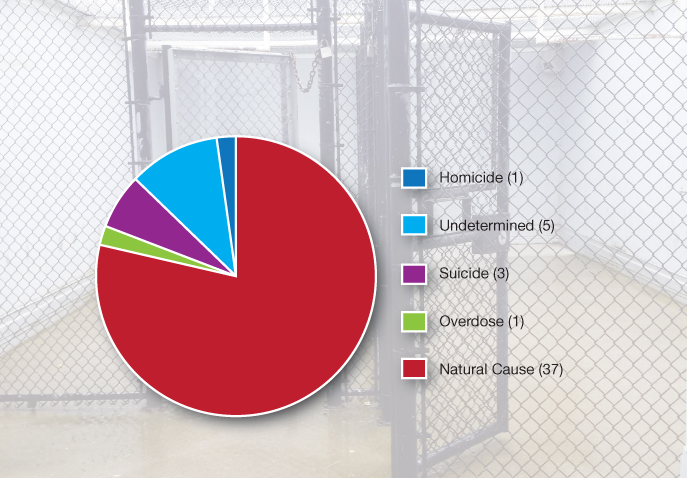
47 deaths occured in federal custody in 2016-2017.
Fatal Response
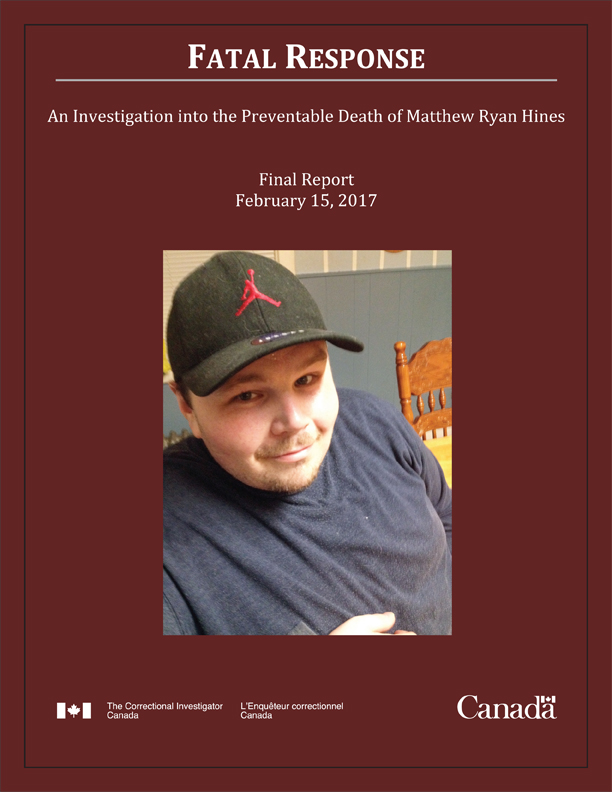
Photo of cover page of Special Report Fatal Response: An Investigation into
the Preventable Death of Matthew Ryan Hines. Final Report, February 15, 2017.
Matthew Ryan Hines was only 33 years old when he died unexpectedly in federal custody following a series of use of force incidents at Dorchester Penitentiary on May 26, 2017. He was serving a five-year federal sentence for robbery and property related offences. Matthew had a history of substance use and mental health issues. On the night in question, responding staff initially thought Matthew was under the influence of an illicit substance. Toxicology reports confirm that Matthews death was not due to an overdose.
I submitted my Final Report of this investigation to the Minister of Public Safety on February 15, 2017. At that time, I requested that it be tabled in Parliament as a Special Report under provisions of the Corrections and Conditional Release Act . This is only the third time in the history of my Office that this provision has been used. In my opinion, Matthews tragic and preventable death is a matter of such urgency and public importance that it could not wait or be deferred. As the Minister of Public Safety had stated in August 2016, Canadians deserve to know how and why Matthew died in federal custody. Fatal Response was tabled in Parliament on May 2, 2017.
My investigation concludes that Matthews death was preventable. The repeated use of pepper spray at very close range seems to have contributed to the medical emergency which ultimately led to Matthews death from acute asphyxia. Matthew appears to have literally choked to death. Staff failed to recognize and respond to his medical distress. My report details a catastrophic and fatal breakdown in the chain of response and accountability. No single responding officer stepped forward to assume leadership and command of an incident that escalated from a routine use of force intervention to a life-threatening event in a matter of minutes.
Key findings of the investigation focus on issues of transparency and accountability in federal corrections. These include:
- Inadequate controls on the use of inflammatory agents (pepper spray) in corrections.
- Security-driven interventions to underlying mental health behaviours.
- Poor communication and inadequate information-sharing among security and clinical staff.
- Failure to recognize and respond to a medical emergency.
- Adequacy and appropriateness of CSC staff investigating and disciplining itself.
- Lack of timely and transparent sharing of information with the family of the deceased.
Despite these and other violations of law and policy, no senior manager has ever been retroactively disciplined or held to account for the staff errors and omissions that contributed to Matthews death.
Fatal Response makes ten recommendations, several of which are directed to addressing gaps in how correctional staff recognize and respond to situations of medical emergency or mental health distress. The Correctional Service acknowledged the areas of concern identified in the report and accepted all ten recommendations. Significantly, the response contains an apology to the Hines family from CSCs Commissioner for inaccurate information that was shared with them following Matthews death. While it is clear that much work remains in preventing deaths in custody, I am encouraged that the Service is committed to learning and making improvements based on the reports findings and recommendations.
Issues in Focus
Fatal Response:
An Investigation into the Preventable Death of Matthew Ryan Hines
Chronology of Events
- The sequence of events leading from use of force to medical emergency and ending in death unfolds remarkably quickly.
- There are two physical altercations with staff, one on Matthews cell range and another in the kitchen area of his living unit. The first use of pepper spray occurs in the kitchen as Matthew is physically restrained by five officers; he is in a prone position with his face down on the floor and handcuffed to the rear.
- From his living unit, Matthew is escorted to segregation where the decontamination shower is located. He is forced to walk backwards with his hands cuffed behind his back. Without warning and under escort of several officers, pepper spray is administered numerous times to Matthews face.
- Matthew suffers the first of several seizures or convulsions in the decontamination shower barely 15 minutes after the initial physical altercation with staff. He never appears to regain consciousness from that point forward. He is dragged by his feet from the segregation shower and taken, by stretcher, to the Penitentiarys treatment room.
- On arrival in the treatment room, Matthew is unconscious, unresponsive and barely breathing. The attending nurse fails to initiate emergency life-saving measures. Matthew is moved into an ambulance, with his hands still cuffed. Less than 50 minutes have elapsed since the initial use of force.
- Emergency life-saving measures are initiated en route to the hospital, but Matthew is declared deceased at Moncton General Hospital shortly after midnight, less than two hours after his brief but fatal encounter with staff.
In the Dark
On August 2, 2016, the Office released In the Dark: An Investigation of Death in Custody Information Sharing and Disclosure Practices in Federal Corrections. The report documents the frustration of families when information is not fully and openly shared following a death of a loved one in custody. The investigation found that even straight- forward factual summaries of the events and circumstances leading to the death were typically not provided. The delays, obstacles and barriers that families encountered in trying to access information about how their family member died in federal custody deny them closure as they grieve their loss. The report concludes that the lack of forthcoming information, numerous delays (investigative reports can be delayed for years), the inappropriate behaviour of some CSC staff and the general feeling that CSC is trying to hide something serve only to compound the grief and hurt of many families.
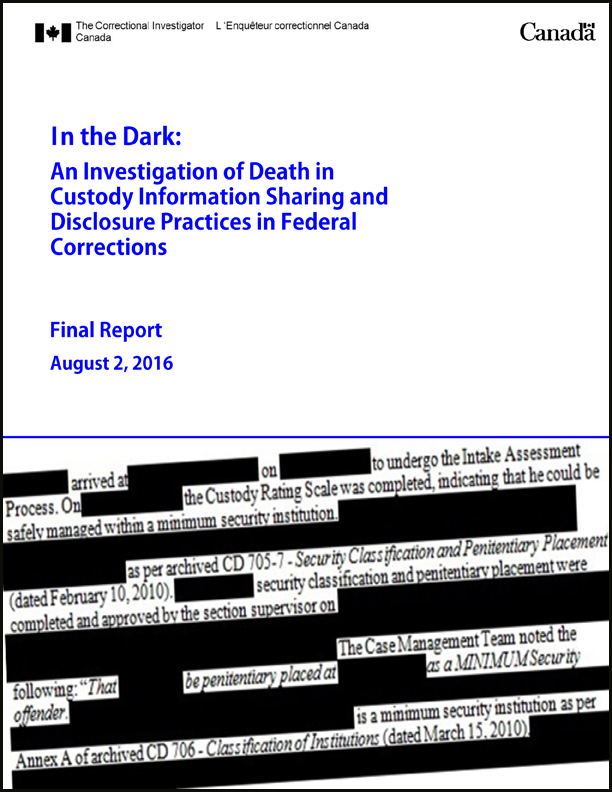
Photo of cover page of OCI report In the Dark: An Investigation of Death in Custody Information Sharing
and Disclosure Practices in Federal Corrections. Final Report, August 2, 2016
The Service has taken a number of important steps to address issues of concern identified in the report. A facilitated disclosure process and regional point of contact for families have been established, which will help ensure families receive timely and relevant information from the point of notification of the death through to the completion of the investigative process. CSC has modified its approach to vetting and releasing information contained in National Board of Investigation (NBOI) reports where a dedicated team works closely with family members and other partners to ensure that information is shared appropriately and consistently. Positively, the Office has noted that NBOI reports that have been released to family members following this revised approach have contained significantly less redactions and provided families with more information. However, careful monitoring of the implementation of these new procedures is necessary. Footnote 14
Other changes the Service has put in place following the release of this report include: immediately sending a letter of condolence to designated next of kin; training for staff involved in communicating with families and; developing a guide for families explaining CSC policy, responsibilities and the investigative process following a death in custody. I am encouraged by the positive response to the reports findings and recommendations. My Office will continue to monitor their implementation.
Issues in Focus
In the Dark:
An Investigation of Death in Custody Information Sharing and Disclosure Practices in Federal Corrections
What We Investigated
- The Office conducted confidential interviews with eight families whose family member died in federal custody or sustained serious bodily injury over the last three years.
- A comparison of redacted (blacked out) National Board of Investigation (NBOI) reports* released by CSC to families through the Access to Information Act versus the original (un-redacted) report was conducted to assess whether CSC consistently and respectfully exercised appropriate discretion in providing families with information.
What We Found
- CSC does not proactively share information with designated next of kin. Information that may eventually be shared is only done so retroactively once a formal access to information request has been submitted by the next of kin
- Documents provided to families by CSC are often heavily and unnecessarily redacted making it difficult for families to piece together what actually happened.
- No one single point of contact is responsible for ensuring that families are informed.
What We Recommend
The report makes nine recommendations, among them:
- The Service should proactively disclose factually relevant information to families of deceased inmates immediately following a death in custody.
- CSC should develop and implement a facilitated disclosure process.
- CSC should establish a family liaison in each of the five regions.
* Pursuant to section 19 of the Corrections and Conditional Release Act, when an inmate dies or suffers serious bodily injury, CSC shall forthwith investigate the matter and report to the Commissioner of Corrections.
Response to Medical Emergencies
In addition to the Matthew Hines case, the Office reviewed a number of other incidents where correctional staff failed to recognize or respond to a medical emergency in a timely and appropriate manner. In relation to the case involving a delayed response to a medical emergency (Case 1), it was my Office that initially brought this case forward to the attention of CSCs National Headquarters, not Regional or institutional authorities. My use of force review team flagged the incident after receiving the use of force package. CSC did not initially identify or code this incident as a case involving serious bodily injury (despite the fact that the victim spent several days in outside hospital), a trigger which warrants and prompts a Board of Investigation process. In Case 2 use of force intervention turned medical emergency there was a failure to recognize medical distress and react accordingly. It is difficult to learn from these events when the post-incident reviews fail to bring forward, much less correct, compliance and accountability issues.
Both cases highlight the importance of responding staff continuously assessing and reassessing events and situations as they evolve. Both scenarios point to serious deficiencies in an intervention model that relies on or prioritizes isolation, control and containment strategies and responses. Such a model may be appropriate for security-based use of force scenarios, but it is inadequate for managing a medical emergency. In a prison setting, a life-threatening event can develop quickly and unexpectedly where the difference between life and death is measured literally in seconds. Finally, both cases underscore the need for round-the-clock health care coverage at all medium, maximum and multi-level federal institutions. The lack of weekend and after-hours on-site medical staff at most penitentiaries is a significant gap in CSCs death in custody prevention efforts.
Conclusion
The lessons to be drawn from the preventable death of Matthew Hines and other near misses could not be any clearer. The circumstances and events that give rise to avertable deaths in custody are not isolated. The omissions, deficiencies and issues of concern identified in Fatal Response are systemic and pervasive in nature; they have all been raised before in the context of previous death in custody investigations. Some still resonate back in time to the preventable death of Ashley Smith (October 2007), including the need for a separate and distinct intervention model to manage medical emergencies. Unfortunately, there are many more Matthews and Ashleys in the federal correctional system. From a prevention standpoint, applying a security-driven intervention model to medical or psychological distress is an inherently risky approach to managing a population that overwhelmingly presents with substance use or dependence, mental health and behavioural issues. The key going forward is to promote and enhance training, skills and techniques that will alert responding staff to events, situations or behaviours before they become life-threatening.
Though I make no further recommendations, I want to conclude this section of my report by referencing the full statement that the family of Matthew Hines issued on the day that Fatal Response was tabled in Parliament. Their words are more powerful and convincing than anything else I can say or recommend on this subject at this time. It is my hope in giving voice to a family who have suffered so much that it will make some positive difference in ensuring that human life and dignity behind bars is preserved and protected as the law demands and Canadians expect.
Issues in Focus
Case 1: Delayed Response to Medical Emergency
- Following what appears to be an unprovoked and extremely violent inmate-on-inmate assault, in which the victim received several closed-hand punches and kicks to the head and torso, a number of correctional officers move in (while filming) to secure the area. The victim is seen lying unresponsive and motionless on the floor.
- The situation is quickly defused as correctional officers handcuff and escort the instigator from the scene. More than five minutes elapse before first aid is administered to the victim. During this time, several correctional officers are seen standing by, next to and even stepping around or over the victim. At one point, an officer appears to kneel down and look closely at the victim, yet emergency assistance is not initiated.
- Given the severity of the assault and the number of correctional officers who are seen standing around and appearing to be doing very little, it seems inconceivable that more than five minutes should lapse before any kind of emergency first aid is provided to the victim.
- The inadequate and delayed response to a medical emergency is compounded by the fact that health care services were not available on site to offer medical assistance because the assault took place after hours.
- Several minutes after correctional officers respond, paramedics arrive. The victim is admitted to outside hospital where he remains for five days in the intensive care unit.
Case 2: Use of Force Turned Medical Emergency
- An inmate was involved in a use of force incident in which an inflammatory agent (pepper spray) was deployed.
- Following the use of force, the inmate was escorted to the decontamination shower where he collapsed under medical distress (possibly as a result of an allergic reaction to the pepper spray).
- The camera operator, who was recording the decontamination shower, observed the inmate in distress (lying on the floor, gasping for air, coughing, spitting, at points unresponsive), yet continued to record, without intervening, for approximately seven minutes before finally calling for assistance.
- While the response was appropriate once initiated, the delay between recognition of a medical emergency and intervention was unacceptable. Additionally, at this institution, there was no after-hours medical staff on site, which resulted in further delay from the first signs of medical distress until outside Emergency Services arrived on scene.
Issues in Focus
Statement from the Family of Matthew Hines
For Immediate Release
Sydney, Nova Scotia: May 2, 2017
Earlier today, the investigation by the Office of the Correctional Investigator into the death of our son and brother at Dorchester Penitentiary on May 26, 2015 was tabled as a Special Report in Parliament by the Minister of Public Safety, the Honourable Ralph Goodale.
When the Honourable Ralph Goodale made a public statement last year that Canadians deserved answers about Matthews death, our lawyer wrote to the Minister to let him know that we were taking him at his word. The clear apology to our family, and most especially to our parents, that is contained in the government response to the Special Report tabled in Parliament today is extremely important to us.
Matthew struggled with mental health issues from the time he was an adolescent. There were few resources for youth and young adults with mental health issues in Cape Breton, and Matthew often found himself in trouble with the law.
In April, 2015 Matthew was living in the community on parole and, when his mental health was obviously deteriorating, we were told that he would get the help he needed if he returned to Dorchester Penitentiary. We believed that to be true. It was not.
Matthew was distraught at being sent back to the Dorchester Penitentiary and his last words to his sister Wendy were: Dont let them kill me.
Matthew died on May 26 th , 2015. We were told that Matthew died of a seizure. We were told that Matthew was a nice man who was loved by the correctional staff and that they were very sorry for his death.
Over a year later, we found out that Matthew died as a direct result of inexplicable and unnecessary physical and chemical force used by the correctional staff who were responsible for his care, and that this was captured in graphic detail on video. As is set out in the Special Report of the Office of the Correctional Investigator, the sheer number of correctional staff who were involved in or witnessed Matthews death is incomprehensible to us. Why did no-one prevent this from happening to him?
We are a large family of hard-working citizens who believe in this country and its institutions. We believe this because our parents raised us that way. The fact that our parents were not told the truth by their government about the circumstances that surrounded Matthews death is, to us, unforgiveable.
The Office of the Correctional Investigator has found that in Matthews case everything that could go wrong did go wrong. We are extremely grateful for the thorough and detailed investigation conducted by the Office of the Correctional Investigator. The commitment that they have shown in the investigation of Matthews death has given us hope that no-one else will suffer as Matthew did. Mr. Zinger travelled with his staff to Sydney to meet with us personally to explain his findings. The compassion and respect shown to us by Mr. Zinger and his staff, in our own home, will not be forgotten.
The Commissioner of Corrections has acknowledged and accepted all ten of the recommendations contained in the Special Report that has been tabled in Parliament. We are encouraged by this. We now await the conclusion of the renewed RCMP investigation into Matthews death, which was re-opened and transferred to Nova Scotia in the fall of 2016.
It is very important to us that Canadians understand Matthews story and understand the truth of what happened to him. No human being who is in prison should be physically and chemically abused by guards as Matthew was. And no human being should ever be ignored by medical personnel when they are in medical distress.
The fact that Matthew was treated with such indignity breaks our heart. We know that Matthew, for all of his struggles, would never have treated another human being that way.
3. Conditions of Confinement
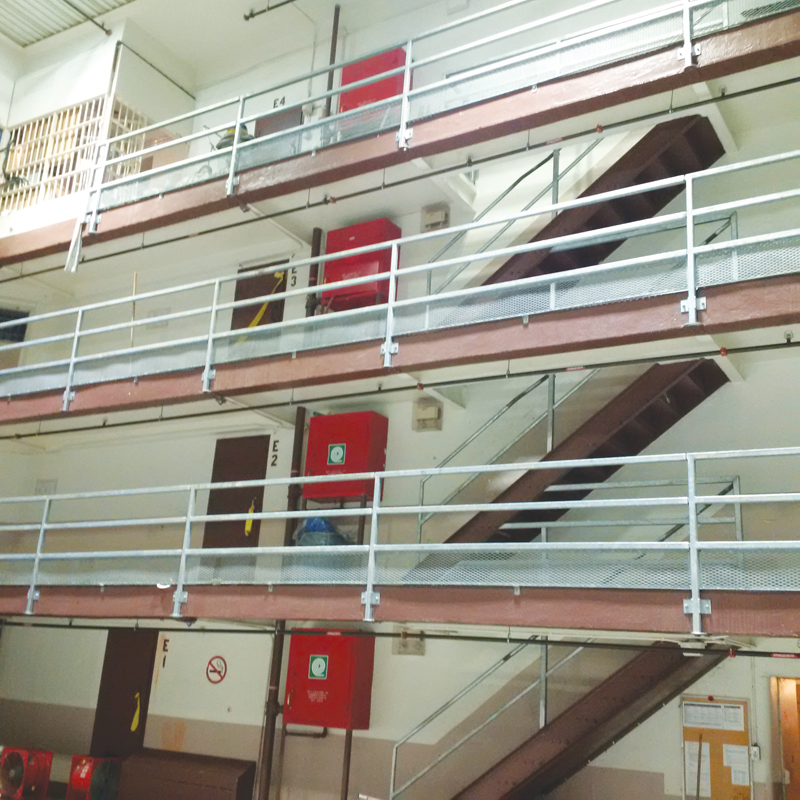
Photo of different levels and ranges at Saskatchewan Penitentiary.
Riot at Saskatchewan Penitentiary
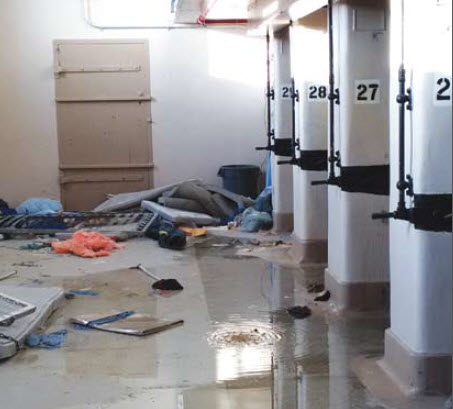
Photo of scattered debris from damaged cells in corridor of
Saskatchewan Penitentiary.
On December 14, 2016, a major riot took place in the medium security sector of Saskatchewan Penitentiary. At its height, close to 200 inmates were involved. Some inmates covered their faces with balaclavas. Range cameras were covered or destroyed, leaving officers with no means of observing events taking place on the ranges. One inmate was murdered. Eight others were taken to outside hospital with injuries sustained as a result of being assaulted, inhaling smoke or chemical agents or being struck by shotgun pellets used to suppress the riot. Damage to several units was extensive, leaving some uninhabitable.
Current research suggests that a lot must go wrong, and for quite some time, before a prison erupts in violence. Footnote 15 Such a perspective implies that prison administrators have opportunity and warning to address precipitating factors and thereby prevent a full-fledged riot from occurring in the first place. In other words, prison riots are not random or inevitable events; they are most likely to occur when a certain threshold of defiance and desperation is reached among a group of prisoners who take matters into their own hands to violently force change or express a long-standing grievance.
The immediate triggering events of the Saskatchewan Penitentiary riot appear to be related to unresolved demands regarding inmate dissatisfaction with food (shortages, replacement items, portion size and protein allotment), as well as perceived mistreatment of inmate kitchen workers (pay, hours, incentives) by CSC staff. When last-minute attempts to resolve these issues failed, tensions escalated. Demands and ultimatums were traded by both sides with inmates refusing to report to work and the Warden eventually ordering a lockdown of the institution. The start of the riot coincided with the call to inmate work at approximately 1:00 pm.
Though the cause(s) and circumstances of the riot are still under CSC investigation, the Office has requested that the Service review the factors that contributed, either directly or indirectly, to an environment of escalating tension, confrontation and eventual riot at Saskatchewan Penitentiary:
- Allegations of conflicts between CSC kitchen staff and inmate kitchen workers.
- Management interpretation and implementation of the National Menu Guidelines and inmate complaints relating to frequency and nature of food item shortages and substitutions; average daily food portion sizes; daily protein allotment.
- Identification and analysis of factors that may have contributed to overall inmate dissatisfaction and willingness to participate in a riot:
- Volume and nature of inmate complaints and grievances.
- Timely response to and resolution of systemic issues (e.g., inmate access to socials, tournaments and other privileges).
- Comparative analysis of use of force incidents, segregation placements, institutional charges, assaults and inmate discipline indicators.
- Frequency of disruptions in normal routine (lockdowns, inmate work refusals/protests, section 53 searches, access to visits).
- Quality and frequency of interactions between correctional staff and an overwhelmingly Indigenous inmate population (dynamic security).
Saskatchewan Penitentiary Riot, December 14, 2016.
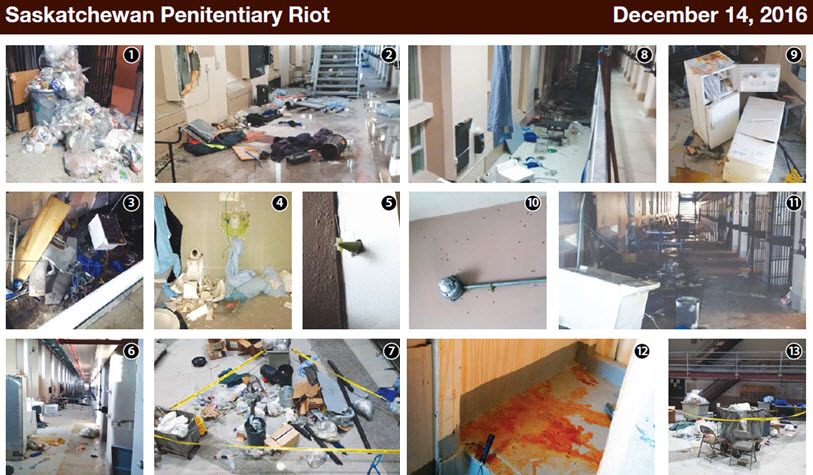
Two page folio showing aftermath of the Saskatchewan Penitentiary riot on December 14, 2016:
- Clean up underway.
- Debris after riot
- Cell effects destroyed during riot.
- Damaged cell.
- Unexploded OC spray (pepper spray) munition.
- Damage and debris from riot.
- Debris in hallway after riot.
- Debris in range after riot.
- Damaged refrigerators in common area.
- Damage to walls from shotgun pellets and painted camera.
- Range view after riot
- Residue from OC spray (pepper spray) used by correctional officers.
- Clean up of debris from riot.
Issues in Focus
Saskatchewan Penitentiary Riot
Chronology of Events
13:15
Inmates from a number of ranges in the medium security sector of the institution refuse to attend work, programs or school.
13:30
Inmates on ranges E 1, 2, 3 and 4 tie off the range barriers with institutional blankets and clothing, barricade the barriers with fridges, washers and dryers in front of the range doors. Inmates cover their faces and destroy range cameras.
13:30
The Crisis Centre is mobilized and opened.
13:40
Emergency Response Team (ERT) members are called in.
14:07
Two negotiators begin negotiations on E3 and 4.
14:10
Inmates make weapons, dismantle beds, damage walls, breach an interior wall, smash windows and generally destroy property.
15:10
Inmates on F4 start fires on the range.
15:40
Deputy Warden reads the Riot Act via the all call system.
15:46
Inmates from F1 and 2 agree to negotiate and are willing to lock up.
16:35
ERT followed by line staff enter E3 and 4 ranges using necessary force (pepper spray and distraction devices) to gain compliance.
16:45
Inmates are removed off the range and assessed by first aid trained staff.
19: 25
The Institution is declared secure.
The Office has also requested that CSC account for the level and degree of force used to suppress the riot (more than 36 kilograms of pepper spray were deployed), including whether the use of firearms (shotguns) was proportionate, reasonable and necessary.
Immediately following the events of December 14, the Office dispatched two Senior Investigators to identify possible causes, as well as monitor and assess the response and situation in the riots aftermath. Several immediate areas of concern were noted, particularly with respect to personal health and hygiene (some prisoners had to sleep in contaminated clothing and bedding), provision of basic living necessities (showers, exercise), as well as access to legal counsel. At that time, the Office made three recommendations:
- Ensure food menus, recipes and portion size meet National requirements.
- Pursue and maintain an open dialogue between management and prisoners.
- Improve relations between CSC kitchen staff and inmate workers.
The Office continues to monitor the return to normal operations and routine at Saskatchewan Penitentiary. I would note positively the measures taken by management to deal with outstanding disciplinary charges arising from the riot, as well as special recognition of the extended period of lockdown and attendant disruptions in routine, visits, access to programs, etc. That said, the high number of complaints brought forward to our Office as well as continuing general unrest at this facility suggests that problems of a systemic nature persist. Incredibly, follow-up visits by this Office have noted continuing issues with food at this facility. I would also note that two of the largest penitentiaries in Canada (also two of the three oldest and arcane) Saskatchewan Penitentiary (1911) and Stony Mountain Institution (1877) are located in the Prairies region. Both institutions happen to house majority populations of Indigenous people. The antiquated conditions of confinement that prevail in these two institutions are not conducive to modern and humane correctional practice, nor responsive to the unique needs of Indigenous prisoners.
- I recommend that the lessons learned from the National Board of Investigation into the December 2016 major disturbance at Saskatchewan Penitentiary be widely circulated within CSC and released as a public document.
Issues in Focus
Legal Implications of the Riot Act Proclamation
- According to the Criminal Code of Canada, a riot is an unlawful assembly that has begun to disturb the peace tumultuously.
- Section 67 of the Criminal Code provides that the Warden or Deputy Warden of a penitentiary, upon receiving notice that twelve or more persons are unlawfully and riotously assembled together, may order the inmates to cease their assembly and disperse.
- When such conditions are met, the Riot Act may be read, which is issued in the following words or words to like effect:
Her Majesty the Queen charges and commands all persons being assembled immediately to disperse and peaceably to depart to their habitations or to their lawful business upon the pain of being guilty of an offence for which, upon conviction, they may be sentenced to imprisonment for life. GOD SAVE THE QUEEN.
- The Riot Act imposes an obligation for the correctional authority to disperse or arrest persons who do not comply with the Proclamation.
- No civil or criminal proceedings can be taken against any officer in respect of any death or injury caused by inmate resistance against the suppression of the riot.
- Further, any person who resists or does not disperse within 30 minutes of reading of the Proclamation is guilty of an indictable offence and liable to imprisonment for life.
Prison Food
As one of the factors that sparked the deadly Saskatchewan Penitentiary riot, food is foundational to health and safety in a prison setting. The HM Inspectorate of Prisons in the United Kingdom recently reported that the low quality of food being served in British prisons, combined with small portion sizes, could serve as a catalyst for aggression and dissent. Footnote 16 The Inspectorates report also found that various medical complications attributable to poor nutrition, including nutritional deficiencies, cardiovascular disease, diabetes and high cholesterol, added to rising prison health care costs.

Photo of vegan meal under National Menu.

Photo of regular meal.
As in the UK, spending on food in Canadian prisons has been decreasing. As part of CSCs contribution to the previous governments Deficit Reduction Action Plan (DRAP), the Service implemented its Food Services Modernization initiative, resulting in total net savings of $6.4M. Core elements of the initiative involved implementation of a National Menu and regional Cook Chill production centres where food is prepared, cooked and chilled in a centralized kitchen. Food is prepared in industrial-sized kettles and tanks up to two weeks in advance, chilled in bulk packaging, stored frozen then shipped to the institutions for retherming. Finishing kitchens add food items to the meal that must be prepared or served fresh.

Photo of an industrial kitchen at Bath Institution.
Photo credit: Standing Senate Committee on Human Rights.
Under the National Menu, the daily cost for food allotted to each inmate is fixed at $5.41. Standardized national recipes are used and weekly menus are followed. Each inmate is given 2,600 calories, which, according to Canadas Food Guide, is sufficient for a low-activity male aged 31 to 50. Footnote 17 Meeting the low daily ration cost, while still complying with minimum nutritional requirements and the standardization of the National Menu, required CSC to find ways of lowering raw food input costs. Among other measures, powdered milk was substituted for fresh milk, bulky meat portions replaced more select cuts, expensive grains were removed, vegetable selection was reduced and English muffins were replaced with toast.

Photo of shelves of freshly baked loaves of bread.

Photo of plates and cutlery on a table after a meal.
Not surprisingly, when these changes were first introduced, inmate grievances related to food issues spiked. As food services modernization was a nationally-directed initiative, inmate complaints and grievances related to food at the local level have largely been passed onto the national level of review and redress. Though the internal grievance rate on food issues is gradually returning to more normal levels as Wardens make local adjustments, it remains elevated. This Office is still receiving complaints related to food portion size (especially protein), quality, selection and substitution of items. Young men (up to age 30), who still make up the majority population in federal penitentiaries, require more than average number of calories and protein and that simply means more food. In some institutions, food has become a commodity that requires monitoring as it can be bartered, sold or traded for other items, including contraband. Playing with the food of hungry and frustrated prisoners can have unintended detrimental effects.
CSC also has a responsibility to accommodate different dietary needs based in religion, conscience or medical reasons. It is estimated that, with the introduction of the National Menu and the cook-chill process, the number of therapeutic diets has actually declined, though there is still significant funding pressure due to an increase in the number of requests for religious and conscience diets such as kosher, halal or gluten free. The added cost of special diets above and beyond the National Menu is being closely monitored to encourage adherence to policy.
- I recommend that an external audit and evaluation of CSC food services be conducted on a priority basis and that the concerns of the inmate population related to portion size, quality, selection and substitution of food items be solicited, heard and addressed immediately by CSC management. The audit should include comparison of ration and per diem meal costs, prior to and after introduction of the food services modernization initiative.
Complaints and Grievances
As my counterpart in the United Kingdom has stated, the ability to complain effectively is integral to a legitimate and civilized prison system. Footnote 18 In my opening message to this years report, I noted my concern with the high volume of issues, requests and complaints brought forward to my Office involving relatively minor matters. Routine and straightforward issues at the institutional level should be properly dealt with at the source, not routinely escalated to my Office. As I see it, the real key to improvement is better and timelier offender complaint and issue management by the Correctional Service.
CSC has an obligation under section 90 of the Corrections and Conditional Release Act to resolve offender grievances fairly and expeditiously. As part of the former governments Deficit Reduction Action Plan, CSC offered up removal of the second (regional) level of its internal inmate complaints and grievance process. This change was supposed to result in a more streamlined, two-tiered system of review and redress of inmate complaints corresponding to a final grievance (institutional) and national level. However, the number of grievances going forward to the national level and the amount of time required to resolve them has led to some egregious delays and mounting backlogs.
According to CSC, with the phasing out of the regional level, 4,600 grievances on average make their way up to the national level of redress each year. Footnote 19 In the first quarter of 2016-17, offenders filed 6,007 grievances at all levels. The majority of grievances were submitted at the complaint and institutional level (79%) while 1,278 were received at the national level. Nearly half of all grievances reaching the national level in the first quarter of 2016-17 required 151 working days or more to resolve (29% took 301+ days). Footnote 20 Some grievance decisions have been delayed as many as 14 times, with wait periods inexplicably extending beyond three years. Eight such cases were raised with the Commissioner in April 2017. In some cases, offenders have been released to the community, even though a response to their grievance is still recorded as pending. The extensive delays are clearly not in accordance with CSCs legal obligation to settle offender grievances expeditiously and can also lead to unfair outcomes.
To manage the number of active and overdue grievances that have piled up at the national level, the Service has added considerable resources to process grievances and clear the backlog. Between October 2016 and March 2017, an additional $900,000 of temporary funding was allocated to resolving National level grievances. In March 2017, $1,500,000 of temporary funding was allocated for 2017-18 to process National-level grievances. While these additional funds will no doubt reduce the number of active and overdue grievances, the effort appears misdirected and unsustainable. A far more efficient option would be to front-load the complaint and grievance process, giving managers the means and capacity to resolve matters expeditiously at source as they arise. In most cases, accountability properly rests at the site level.
To further compound and complicate matters, in April 2017, CSC terminated the Alternative Dispute Resolution (ADR) pilot project that had been running at five (reduced from ten) institutions. At various times, the initiative had proven successful at resolving as many as half of all complaints and grievances at the local site level, though the resolution rate for 2016/17 was 28%. Despite these encouraging results, ADR funds have been redirected to deal with the backlog in national level grievances. An additional 28 full time employees will be hired at National Headquarters in 2017-18, on top of a funded contingent of 36 FTEs in the Offender Redress division just to relieve the national level grievance backlog. In comparison, my Office has 36 full-time employees.
I simply fail to see the justification or rationale behind these decisions. Pumping more resources into trying to salvage a broken and dysfunctional system seems poorly conceived and wasteful.
- I recommend reinstatement and expansion of the Alternative Dispute Resolution pilot program at all medium and maximum security penitentiaries.
Update on Segregation (Solitary Confinement)
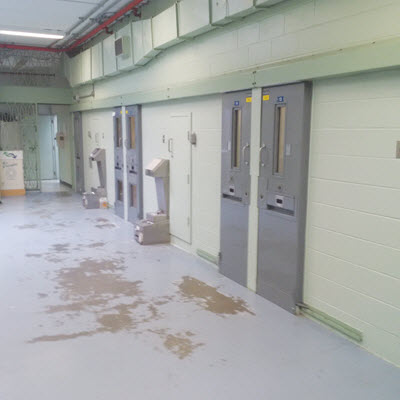
Photo of segregation range.

Photo of food slot in segregation cell door.
A recent Status Report on Administrative Segregation conducted by CSCs internal audit sector confirms that the use of segregation in federal prisons over the past two years has been significantly reduced. Footnote 21 On January 1, 2017, there were 391 inmates in administrative segregation (2.76% of the total inmate population) compared with 780 in April 2014. The average stay in segregation has also significantly declined from 34.5 days in 2014/15 to 23.1 days in 2016/17. Footnote 22 CSC research publications Footnote 23 and audit findings attribute the substantial declines in segregation counts, admissions and length of stay to improved operational practice and enhanced management oversight. Despite no changes to the legal framework, four strategies in particular referrals to mental health services, earlier review of cases, increased use of inter-regional transfers and creation of additional sub-populations seem to be largely responsible for the sharp declines. Significantly, audit results confirm that the reduced use of segregation has not had any perceptible impact on the safety and security of staff or inmates.
Significant reductions in segregation admissions and length of stay are encouraging. But there is more work to be done. Based on my recent visits, there is room for improvement in how segregation units currently operate and how the Correctional Service positively meets its obligation to mitigate the known harmful effects of isolation/solitary confinement. I would highlight the following set of concerns:
- Indigenous inmates are still more likely to experience segregation and they continue to stay longer than any other group. As of March 31, 2017, there were 414 offenders in segregation, 151 of whom (36.5%) were Indigenous.
- The distinction, in the law, between involuntary and voluntary segregation (protective custody) has always been dubious and is increasingly indefensible. Assuming risks and threats to personal safety were removed, no reasonable person would voluntarily agree to be housed in the most restrictive and depriving form of custody the State can legally impose.
- The material conditions of confinement in segregation continue to be problematic. Segregated inmates should have access to a full range of basic activities, facilities and services, such as showers, outdoor exercise, out-of-cell time, personal effects, reading materials, chaplaincy, health care, visits and correspondence. To ensure the harmful impact of isolation is mitigated, daily segregation routines and activities need to be more varied. Staff working in segregation areas should be trained and selected for their ability to interact positively with segregated inmates. Footnote 24 The segregation area itself should be well-maintained and clean, with good ventilation and a source of in-cell natural light. To the extent possible, provision of articles such as kettles, televisions and radios should be based on dynamic and individual risk assessment, not denied as a matter of policy.
- Finally, it is not at all clear where those who would otherwise have been placed in administrative segregation are ending up. My concern arises from the fact that, in the absence of other alternatives, specialized units (dubbed segregation lite) may be used to manage groups of offenders (sub-populations) with behavioural, emotional or cognitive issues. These units often have restricted routines, including limited out-of-cell and association time. Known by various names, such as structured or enhanced supervision, they may approximate (but not quite reach) the international definition of solitary confinement as 22 hours or more a day without meaningful human contact. Footnote 25 Technically not solitary confinement, in the CSC context it may just be segregation by any other name or means.
On June 19, 2017, the Government introduced Bill C-56 An Act to amend the Corrections and Conditional Release Act and the Abolition of Early Parole Act. The proposed legislation is significant as it introduces a 15-day presumptive limit on segregation stays, establishes an Independent External Reviewer mechanism to look at rare and exceptional cases that would extend beyond the 15 day limit, and includes significant reforms to conditions of confinement in segregation. These are positive steps. I look forward to participating in the review process as this bill makes its way through Parliament.

Photo of a segregation range.

Photo of a rusting segregation cell door.
Use of Force Reviews Trends and Observations
The Office reviewed 1,436 use of force incidents in 2016-2017.
Trends and Observations:
- Indigenous offenders accounted for 25% of all use of force incidents reviewed.
- Black offenders accounted for 17% of all reviewed use of force incidents
- The Situation Management Model (SMM) was not followed in 11% of all interventions reviewed.
- 28% of all reviewed use of forces incidents identified compliance issues with decontamination procedures after the use of chemical or inflammatory agents.
- 43% of all the reviews indicated deficiencies with the post-use of force health care assessments.
- Strip search procedures were not followed in 25% of all interventions.
- Offenders alleged inappropriate levels of force used in 6% of all incidents reviewed.
- Use of force interventions involving self-injury incidents represented 13%.
- 67% of all the reviews indicated compliance issues with video recording procedures.
- 37% of all reviewed use of force incidents occurred in the offenders cell.
Disclosure of Use of Force Videos
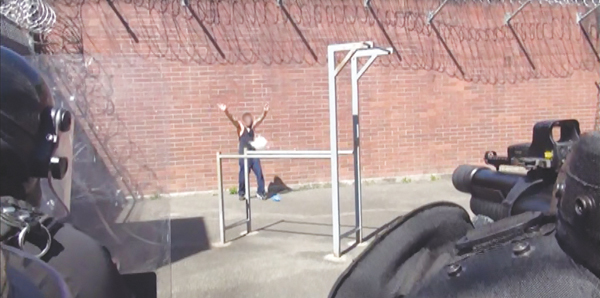
Photo of an inmate in outdoor yard being struck by an impact round.
As part of its oversight role, the Office reviews all use of force incidents in federal correctional facilities. In 2016-17, the Office reviewed 1,436 interventions involving use of force. The process involves assessment of all use of force documentation, including incident-related video recordings, to ensure legal and policy compliance. Our reviews uncover systemic deficiencies in use of force policy and procedure. In 2016-17, more than two thirds of all the reviews indicated compliance problems with video recording procedures. The most commonly identified deficiency relates to the timely deployment of a handheld recording device during a use of force incident.
As other public safety agencies understand, video records are a means to protect front-line responders from unwanted or unwarranted allegations, demonstrable assurance that force was used as a last resort, and in a proportionate and judicious manner. Permitting access to and disclosure of video records to legitimate requestors is a means of demonstrating openness and transparency. Unfortunately, such principles appear not to be well ingrained in CSC organizational culture. In assessing requests for video records it bears reminding that personal information belongs to the person, not the Service; therefore legitimate requestors are entitled to access it unless there is a valid legal reason to withhold or exempt it.
According to data supplied by CSC to my Office, over a three-year period (2013/14 to 2015/16) a total of 353 requests were made to CSC under the Privacy Act or the Access to Information Act that included or required processing of use of force video recordings. Of that total, only 31 video records were disclosed either in full or in part. In other words, the majority of requests never resulted in a disclosure of any kind. Various reasons for not disclosing are provided: the records were exempted, withheld, abandoned by the applicant, or otherwise labelled in progress, waiting for records or no record exist. The most commonly applied exemption was Section 22(1) of the Privacy Act , provisions of which relate to information that could be injurious to the conduct of lawful investigations or disclosure of which could reasonably be expected to be injurious to the security of penal institutions.
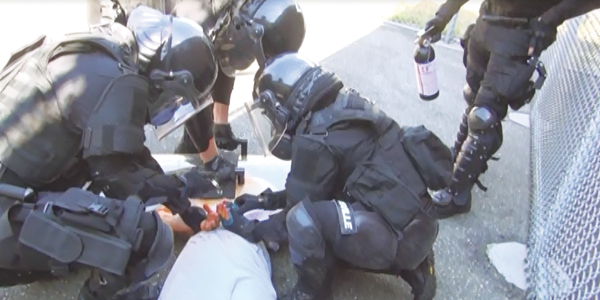
Photo of four officers from the emergency response team dressed in full protective equipment restraining an inmate.
In our judgement, there does not seem to be much basis to the underlying claim that safety or security of the institution would be compromised if the video record was disclosed. Most use of force interventions take place in-cell or other common rooms and settings halls, yards, ranges. These would minimally give rise to legitimate security exemptions (e.g. control posts or perimeter security). Moreover, use of force interventions tend to follow established procedures that are very familiar to inmates. In all likelihood, even full disclosures would not compromise future interventions.
When access is presumptively denied, confidence and trust in correctional authorities are diminished. CSC has been able to create the perception, internally and externally, that use of force video recordings are out of bounds when in fact they should be routinely provided whenever inmates who are the subject of these interventions or their legal representatives request them. Few even appeal denial of requests to the Privacy or Information Commissioners. Finally, though editing technology exists that can alter or anonymize video images so that personnel, sources and facilities are not compromised, CSC seems to have some technical difficulties applying this technology or training staff to use it. I believe that compliance with use of force policy and procedure will improve as use of force videos are disclosed on a more routine basis.
- I recommend that CSC publish on its public website the process for requesting use of force video recordings, including the legal criteria for exemptions and disclosure. CSC should inform the inmate population of their right to access use of force video recordings.
Prison Visits and Visitors
71 (1) In order to promote relationships between inmates and the community, an inmate is entitled to have reasonable contact, including visits and correspondence, with family, friends and other persons from outside the penitentiary, subject to such reasonable limits as are prescribed for protecting the security of the penitentiary or the safety of persons. Corrections and Conditional Release Act
The importance of visits to prisoners cannot be overstated. Regular visits with family members and friends provide an important opportunity to maintain supportive contacts, contributing to rehabilitation and reintegration aims. A missed or cancelled visit can have a significant impact on the emotional and psychological well-being incarcerated individuals.
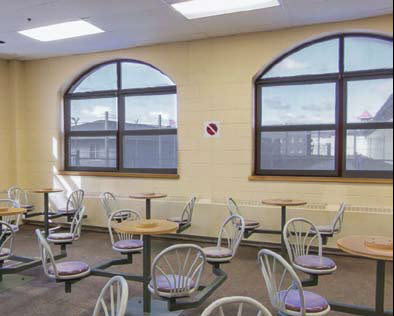
Photo of a visitors area at a federal penitentiary.
Photo credit: Correctional Service of Canada
Visitors are not always treated with courtesy and respect by staff. Family members and friends often experience long delays in entering CSC facilities. It can take weeks or months to be approved for prison visits. Visitors often report feeling highly anxious, stressed and even stigmatized by invasive security checks and measures conducted at the front entrance.
Issues in Focus
Ion Scanners in Federal Corrections

Photo of an Ion scanner.
Photo credit: Correctional Service
of Canada
Ion Mobility Spectrometry devices, also known as ion scanners, were first introduced in federal correctional facilities in 1995. Their purpose is to improve detection of illicit drugs and substances and prevent them from entering institutions. Samples are collected by wiping or vacuuming objects, then placing the filter or swipe into the unit. These machines can be oversensitive and unreliable, and often produce what are known as false positive results.*
The following record is based on the experience of a mother and grandson who were trying to visit a family member in a federal prison:
- She and her grandson prepare for their visits by wearing freshly cleaned clothes and thoroughly washing their coins (for the vending machine in the visiting area). She does not wear any jewellery when visiting.
- She does not stop anywhere along the 3.5 hour drive to the institution, not even to use the bathroom because she could pick up trace amounts of illegal substances in public bathrooms or on door handles.
- Upon their arrival, the CSC officer asked to test her car keys that she had placed in a locker. They tested positive for opium.
- A detector dog inspected both of them and gave them a pass.
- A second ion spectrum test was done on the lining of her jeans pocket, but was deemed inconclusive due to a malfunction in the scanner.
- However, because of the initial positive test, she (and her grandson) had to wait until the end of visiting hours and were only permitted to visit their family member from behind a physical glass barrier.
- Her grandson was unable to hug his father.
* CSC, Use of Ion Scanners in Correctional Facilities: An International Review (July 2011)
As per CSC policy on the Use of Non-Intrusive Search Tools , when a positive hit on the ion scanner occurs, the visitor is subjected to a second test, and a subsequent Threat Risk Assessment (TRA). In this assessment, the individual may be tested by a drug detector dog, or other searches as necessary. The individual is then interviewed by the assigned manager to explain the positive search result. It is ultimately up to the discretion of the designated manager to consider the results of all searches and tests, as well as the information obtained during the interview and from the visitors history. This consideration will be used as the basis for determining the individuals visitation privileges.
Despite the use of other searches and interviews, positive results from the ion scanner nevertheless continue to generate individual suspicion, despite the frequency of false positive results. Upon reviewing 3,532 incident reports involving visitors from February 2015 to April 2017, the Office found that approximately 25% of these incidents showed a positive hit on the ion scanner over the threshold limit. The refusal rates for visits due to positive ion scanner tests were about 18%, indicating that there is a need to review the use of these devices in federal corrections, as well as the TRA process that is employed in denying visitor access. Moreover, the introduction of ion scanners has failed to have any significant impact on the rate of positive random urinalysis drug testing results. The rate has remained stable Footnote 26 despite significant investments in new detection (e.g. drug dogs) and surveillance technologies designed to stop drugs from entering federal institutions.
- I recommend that CSC conduct a review of its prison visitor program, to include an updated evaluation of the use and reliability of Ion Mobility Spectrometry devices, and report the results to the Canadian public.
Prison Transport Vans
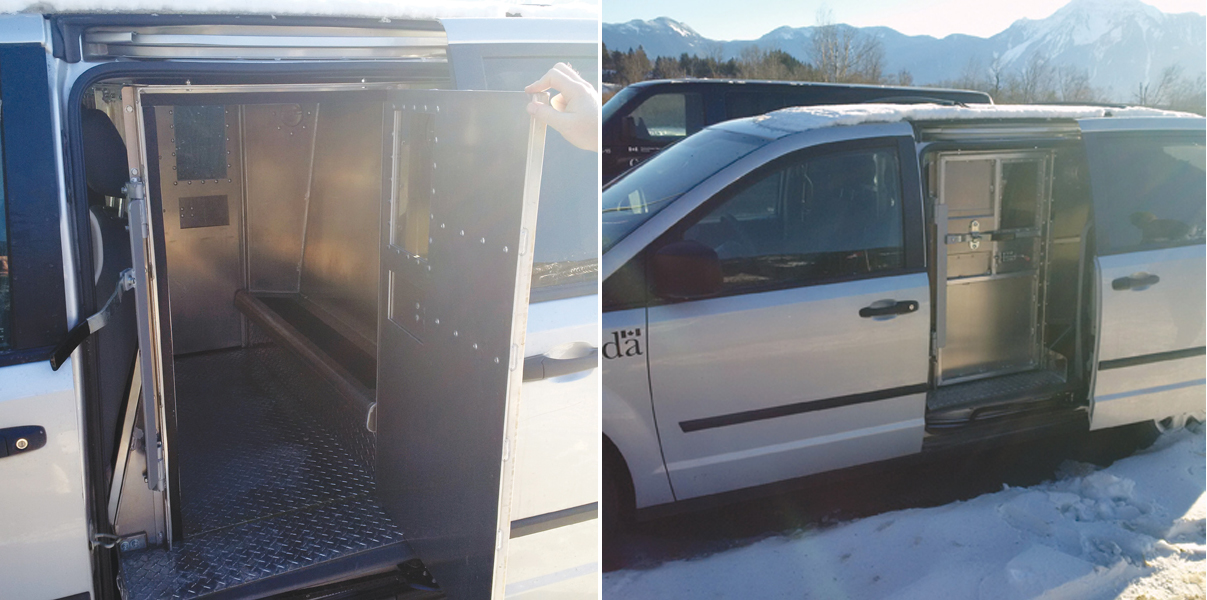
Photo of the interior/exterior of an inmate transport van.
I mentioned in my opening message the claustrophobic experience I had in sitting scrunched in the back of one of CSCs security escort vans which are used to take prisoners to attend court or medical appointments. The experience left me feeling as if personal safety and human dignity did not matter to the designers or operators of such vehicles. Completely enclosed in metal, the compartment insert where shackled prisoners are kept is totally devoid of any comfort or safety feature, including seatbelts. Footnote 27 These vehicles, which are essentially retrofitted and modified family minivans (e.g. Dodge Caravan), were never designed or crash-tested with a metal compartment of this size. Should there be an accident, as occurred in New Brunswick in 2013, individuals within the compartment would literally be thrown around inside, which could result in critical injury or even death.
My Office and some CSC staff who operate these vehicles have brought these design and safety concerns forward to the Service in the past. This mode of conveyance does not befit safe and humane transport. In response, rather than express a willingness to bring their security escort fleet up to industry safety standards (as used by the RCMP), the Service simply recites that its modified vehicles meet the manufacturers weight load capacity and are compliant with the federal Motor Vehicle Safety Act . This position simply fails to acknowledge the fact that the design is fundamentally unsafe and untested. Furthermore, there are no federal guidelines for inmate transport vehicles.
- I recommend that, over the next two years, CSC remove the current fleet of security escort vehicles (small minivans) as their design is substandard and unsafe and replace them with larger vehicles meeting industry standards in policing (e.g. RCMP).
4. Indigenous Corrections

Photo of the Huli Tun (or Healing Lodge) at Pacific Institution.
We call upon federal, provincial, and territorial governments to commit to eliminating the overrepresentation of Aboriginal people in custody over the next decade, and to issue detailed annual reports that monitor and evaluate progress in doing so. Truth and Reconciliation Commission, Final Report, December 2015.
Context
Between 2007 and 2016, while the overall federal prison population increased by less than 5%, the Indigenous prison population increased by 39%. Footnote 28 For the last three decades, there has been an increase every single year in the federal incarceration rate for Indigenous people. Footnote 29 Today, while Indigenous people make up less than 5% of the Canadian population, as a group they comprise 26.4% of the total federal inmate population. 37.6% of the federal women inmate population is Indigenous. I cannot help but think that the over-incarceration of First Nations, Mtis and Inuit people in corrections is among the most pressing social justice and human rights issues in Canada today.
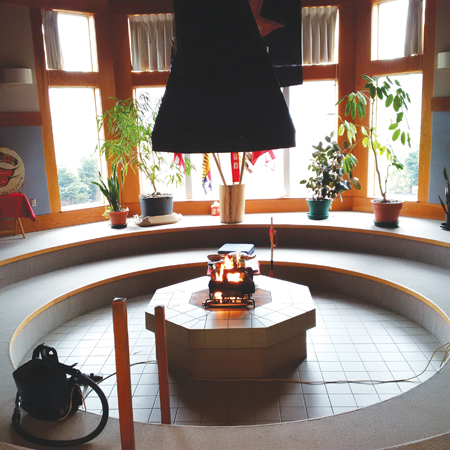
Photo of the interior of the Healing Lodge at Pacific Institution.
Auditor Generals Report Preparing Indigenous Offenders for Release
Tabled in Parliament on November 29, 2016, Report 3 of the Auditor General of Canadas Fall Reports examines CSCs programs that prepare Indigenous persons for reintegration into the community. Footnote 30 In many key areas, the Auditor Generals report independently corroborates many areas of concern repeatedly identified by this Office:
- In 2015-16, most Indigenous offenders were released from custody at their statutory release date, having served two thirds of their sentence.
- Of those released on statute, 79% were released into the community directly from a maximum or medium security institution, without benefit of a graduated and structured return to the community.
- Parole grant rates were much lower for Indigenous than non-Indigenous offenders:
- Only 12% of Indigenous offenders had their cases prepared for a parole hearing once they were eligible.
- An overwhelming 83% of Indigenous offenders postponed their parole hearings.
- On average, Indigenous offenders waited five months from the point they began their sentence to the start of their correctional programming. Only 20% of Indigenous individuals were able to complete their programs by the time they were first eligible for release.
- CSC has yet to develop tools to assess how culturally specific correctional interventions for Indigenous offenders, such as Elder services, Healing Lodges, Pathways Initiatives and partnerships with community groups and organizations contribute to an offenders progress toward successful reintegration.
- CSC sometimes makes security assessments and program referrals for incarcerated Indigenous persons without adequate information from the provincial or territorial courts system. CSC assessments and program referrals can be delayed for months awaiting this information.
- Indigenous persons are more likely than non-Indigenous persons to receive higher security classifications.
- CSC does not provide staff with adequate guidance or training on how Aboriginal social history should be considered in case management decisions.
None of these findings come as a surprise to me, though I am encouraged by CSCs response to the Auditor Generals report. In an open letter to the Auditor General, the Commissioner of Corrections indicated that the report marks a milestone in Canadas correctional history and that the Service fully accepts all of the reports findings and recommendations. In terms of specifics, the Commissioner offered four initiatives:

Photo of the interior of Pacific Institution.
- Review the way the Service manages individual case files to ensure Indigenous offenders are prepared for the earliest appropriate release into the community.
- Place renewed focus on preparing low-risk offenders for early release.
- Increase the availability of and access to programs tailored to the needs of Indigenous offenders.
- Make best use of Elders, Pathways Initiatives and Healing Lodges.
The Commissioner further ensured that leadership within the Service will be held accountable to deliver much-needed improvements and results in this area.
As promising as CSCs response to the AGs report is, much remains to be done. There is still a significant, seemingly intractable, performance gap that separates Indigenous from non-Indigenous offenders. Indigenous people in federal custody are:
- Released later in their sentence.
- Disproportionately over-represented in segregation placements, use of force interventions, maximum security institutions and self-injurious incidents.
- More likely to be returned to prison due to suspension or revocation of parole.
In spite of faster entry into correctional programs and higher program completion rates, Indigenous offenders are still being released later and revoked more often than their counterparts. These results seem to defy reality. The majority of Aboriginal offenders admitted on a warrant of committal (WOC) to federal custody are serving relatively short sentences. In 2014/15, just over half (52%) of the Aboriginal offenders admitted on a WOC were sentenced to less than three years. Another 37% percent of Aboriginal offenders were sentenced to three to six years. Overall, 78% of Aboriginal offenders in this group were considered to be engaged in their correctional plan upon admission. Footnote 31 If the majority of Indigenous offenders are serving comparatively short sentences, and if most are engaged in their correctional programming, why arent they being returned to the community at the earliest possible opportunity?
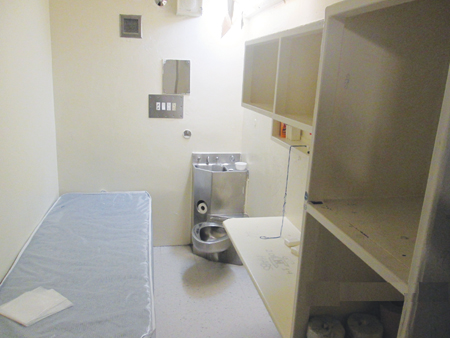
Photo of a segregation cell.
Some of the answers to improving results lie in better use of Aboriginal-specific provisions of the Corrections and Conditional Release Act . Two provisions in particular, both of which were intended to be used as alternative release options for Indigenous offenders, are chronically under-funded and under-utilized in federal corrections. Section 81 allows for Indigenous communities to oversee the care and custody of Indigenous offenders who would otherwise be in a federal prison. Section 84 allows for an Aboriginal community to propose a plan for an interested and consenting Aboriginal inmates release and reintegration into that community.
With respect to Section 81 provisions, there are nine healing lodges, four of which are managed and operated by Indigenous communities. Bed space in the community to support Indigenous offenders is limited, as there are no Section 81 agreements in British Columbia, Ontario, Atlantic Canada or the North. Three of the four Section 81 facilities are on reserve land, yet most Indigenous offenders are being released to urban settings. Inexplicably, there continues to be substantial funding discrepancies, as well as differences in terms and conditions of work, between Section 81 Healing Lodges operated by Aboriginal communities and those operated by the CSC. Finally, all Section 81 facilities are designated minimum security, yet Indigenous prisoners are predominantly classified and released from medium or maximum security institutions. Consequently, the dedicated facilities designed to assist Indigenous offenders to safely and successfully return to the community do not necessarily operate as intended or at capacity.

Close-up photo of wood carving at Pacific Institution.
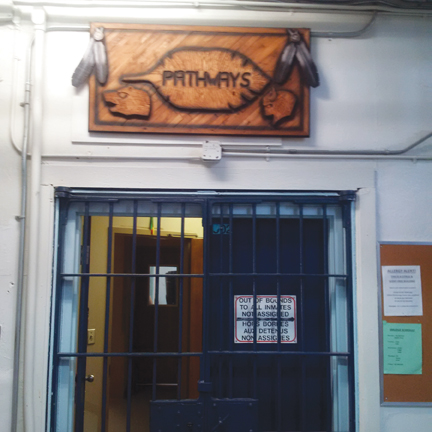
Photo of Pathways range at a federal penitentiary.
In recent years, there has been a gradual and sustained increase in Section 84 releases. However, this bit of encouraging results is tempered by the fact that this option is being accessed by more Indigenous offenders who reach statutory release (two thirds point of their sentence). In other words, the increase in Section 84 releases is due less to increased CSC effort or enhanced community capacity and more to a technical change in the administration of the sentence for Indigenous offenders.
It is clear that more of the same will not produce better or different results. My Office will closely monitor CSCs progress in meeting its commitments to the AGs report. As the Commissioner stated, more can and will be done to support the successful rehabilitation and reintegration of Indigenous offenders. In the meantime, I offer a recommendation of my own:
- I recommend that CSC review its community release strategy for Indigenous offenders with a view to:
- increase the number of Section 81 agreements to include community accommodation options for the care and custody of medium security inmates;
- address discrepancies in funding arrangements between CSC and Aboriginal-managed Healing Lodge facilities, and;
- maximize community interest and engagement in release planning for Indigenous offenders at the earliest opportunity.
5. Safe and Timely Community Reintegration
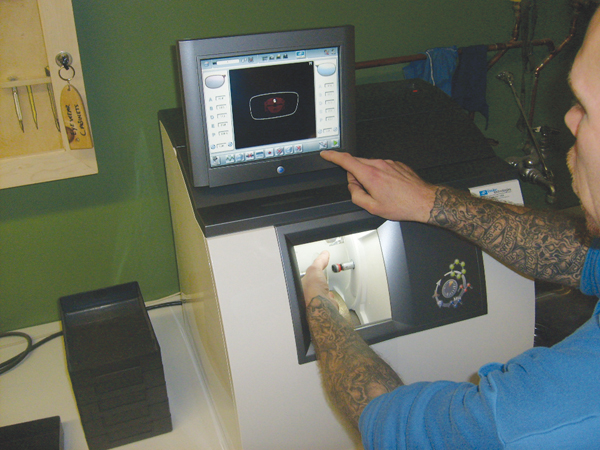
Photo of an offender using machinery to cut a glass lens for eyewear.
Barriers to Community Reintegration Prison Work and Employment

Source: CSC Research, Reintegration Challenges Facing Women Offenders (February 2014)

Photo of a Corcan woodworking shop.

Photo of a Corcan shop.
It is encouraging to see that, after a decade of decline and major policy reversals, conditional release indicators are finally beginning to trend in a positive direction. Parole grant rates are increasing while the number of offenders on statutory release (two thirds of sentence) is starting to come down. While many barriers and challenges remain for offenders returning to the community, none is perhaps more daunting than finding and securing employment with a criminal record. Approximately 60% of inmates at admission to federal custody have an identified employment need.
CORCAN, which is a special operating agency within the CSC, offers employment training and employability skills to federal offenders. Its goal is to help offenders acquire marketable job skills in prison so they can obtain gainful employment upon release. CORCAN operates just over 100 shops in 29 federal prisons. Planned spending on CORCAN for 2017-18 is $36.613M. Footnote 32 The agency has four main business or product lines: manufacturing, services, textiles and construction. At any given time, CORCAN industries employ less than 10% of the total inmate population.
In visiting prisons, I am often impressed by CORCAN shops and facilities, as well as the dedication and commitment of staff. The problem, as I see it, lies not in these areas, but rather in the shortage of CORCAN jobs and other meaningful work, skills acquisition and training opportunities behind bars. While I have seen some excellent examples of offenders productively engaged in prison industries, I also observed too many other instances where offenders were either unemployed or underemployed or not participating in any sort of educational, vocational or correctional programming. At regional womens facilities, I noted that the CORCAN shops are primarily textiles; women inmates were almost exclusively engaged in gendered, stereotyped jobs such as textiles, laundry and sewing. Output typically includes towels, aprons, pillow cases, sheets, drapery and blankets.
Offenders report that employment in prison industries provides a pro-social means to structure their prison time. Benefits described by offenders participating in CORCAN industries include higher wages, positive references, more appealing jobs and opportunity to earn apprenticeship hours for certified Red Seal trades. These are desirable goals that seem well within reach.
The Office has often noted need for improvement in how the prison employment and vocational skills training program is run and delivered in federal institutions. We have made the following suggestions:
- More direct partnerships between CORCAN and the leading sectors of Canadian industry, which primarily means reducing emphasis and reliance on prison textile industries.
- Increase opportunities for inmates to engage in community employment and training, including considerably expanding the use of work releases.
- Enhance and expand opportunities to learn and apprentice for a Red Seal trade inside federal institutions.
- Revaluate inmate pay, the rates for which were first set in 1981 and have remained frozen ever since. Ensure financial incentives are part of the inmate pay structure to influence quality and value of prison work consistent with community expectations.
- Increase emphasis on computer literacy and practical applications of information technology in the Canadian economy.
To my mind, a clear corporate vision and commitment to provide relevant and meaningful skills training and a decent work experience for federal offenders is lacking. More transparency and accountability in CORCAN activities and operations is also required, including more recent, regular and relevant reporting on results for offenders and Canadians. If given the opportunity, people behind bars want to learn, acquire and upgrade the skills and work experience that will help them succeed on the outside.
- I recommend that the Minister of Public Safety request that the Standing Committee on Public Safety and National Security (SECU) conduct a special study on inmate work and prison industries (CORCAN).
- I recommend that the prison farm program be reinstated under CORCAN direction.
Updates on the Black Offender Experience in Federal Custody
In 2013, the Office released A Case Study of Diversity in Corrections: The Black Inmate Experience in Federal Penitentiaries. At that time, the Office reported that Black inmates comprised 9.5% of the inmate population while representing just 3% of the Canadian population. The report also noted that Black inmates were over-represented in maximum security and segregation, incurred a disproportionate number of institutional charges, and were more likely to be involved in incidents of use of force. Although CSCs response to the Offices report was positive overall, four years later very little appears to have changed for Black people in federal custody.
Today, Black inmates currently comprise 8.6% of the total incarcerated population. Footnote 33 While the total number of Black inmates has decreased by 9% since the Offices 2013 study, the overall inmate population has also decreased (6.3%) over the same time period. Ontario continues to have the largest Black inmate population nearly three times the number in the Quebec region (the region with the second largest Black inmate population).
The number of federally sentenced Black women has decreased by nearly 30% since the Offices 2013 study (55 in 2013 versus 39 in 2017). Similar to the 2013 study, Black women are primarily incarcerated for Schedule II (drug) offences (54% in 2017). In 2017, almost one quarter of incarcerated Black women in Canadian penitentiaries were foreign nationals. These women will be deported upon completion of their sentence.
As a group, Black inmates continue to have poorer outcomes on many important correctional indicators. In 2016-2017, Black inmates were:
- More likely to classified as maximum security (nearly one-fifth compared to 14% of the total inmate population).
- Over-represented in admissions to segregation (Black inmates represented 10.5% of admissions to segregation).
- Disproportionately involved in incidents of use of force (Black inmates represented 10.6% of offenders involved in a use of force incident).
- More likely to be gang affiliated (Black inmates were nearly twice as likely as the total inmate population 22% versus 12% to be gang affiliated).
In October 2016, the United Nations (UN) Working Group of Experts on People of African Descent visited Canada to observe the human rights situation of African-Canadians. It was the first time in three years that Canada had received a thematic UN Special Procedures mandate holder. Footnote 34 As part of its fact-finding mission, the Office presented the findings from its 2013 case study on the Black inmate experience to the Working Group. The Offices presentation was important as it was one of very few in the criminal justice field that focussed specifically on the experiences of Black Canadians, rather than the more generic and general category of visible minorities. As noted by the UN Working Group, visible minorities are not a homogeneous group, underscoring the importance of examining the experiences of specific groups separately.
Upon the conclusion of its visit, on October 21, 2016 the United Nations Working Group of Experts on People of African Descent issued its preliminary findings and recommendations, many of which mirrored those made by the Office: Footnote 35
- Ratification of the Optional Protocol to the International Convention against Torture, Cruel, Inhuman and Degrading Treatment or Punishment.
- Development and implementation of a National Corrections Strategy to correct the disproportionately high rates of African Canadians within the correctional system and ensure anti-discriminatory and culturally specific services for African Canadian offenders.
- For the CSC, adopt a national diversity awareness training plan and appoint an ethnicity liaison officer in each institution.
- Increase the representation of people of African descent in law enforcement and correctional services.
The UN Working Group will present its final report to the UN Human Rights Council in September 2017. The Office encourages the Government of Canada and more specifically CSC, to move forward on these recommendations to ensure Black Canadians in custody are adequately prepared and supported for release. In addressing over-representation of Black offenders in federal custody, the Service is encouraged to take into consideration factors that disproportionately impact on Black Canadians, much like Aboriginal social history is used in respect of Indigenous offenders
Lifeline
Created in 1991 by CSC, the LifeLine program recruited long-term offenders lifers who had successfully reintegrated into the community for at least five years to mentor others facing life sentences. The award-winning program helped reintegrate those serving a life sentence back into the community. CSC research showed that inmates involved in Lifeline were less likely to get into problems while in prison or end up in segregation. The program, estimated to cost $2M annually, was terminated in August 2012 as part of broader cuts to CSCs budget.
Today, just over 3,000 inmates (21% of the total inmate population) are serving a life sentence. There are more than 1,700 life-sentenced offenders who have been paroled and living in the community. There is a continuing and demonstrated need to bring back a program that helps prepare offenders to safely reintegrate back into society after serving a lengthy sentence behind bars.
- I recommend reinstatement of the LifeLine program.
6. Federally Sentenced Women

Photo of the Secure Unit at Fraser Valley Institution for federally sentenced women.
Special Focus
Maxed Out: A Review of the Secure Units at the Regional Womens Facilities
Context
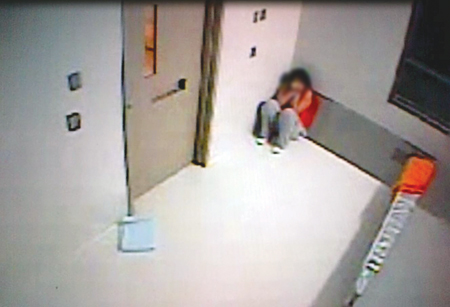
Photo of a female inmate in the corner of a segregation cell.
Female offenders, and, in particular, Indigenous women are the fastest growing population in Canadian corrections. In the ten-year period between 2007/08 and 2016/17, the number of federally sentenced women inmates increased by 29.7% (535 in 2007/08 to 694 in 2016/17). The number of Indigenous women inmates increased at an even faster pace growing by 60% over the same period. Given that four of the five regional womens institutions were constructed 20 years ago, the growth in the population has created unique population management challenges, particularly with respect to the secure units. The secure units are separate maximum security units that operate within all five womens multi-level facilities. Footnote 36 Maximum security women represent 11% of the overall federally sentenced women population. Indigenous women represent 37% of all women behind bars, but they make up 50% of the maximum security population and present with unique culturally-based needs.
Over the past fiscal year, the Office investigated numerous complaints linked to the conditions of confinement in the womens secure (maximum security) unit, specifically with respect to gaps in dynamic security practices that had serious consequences on the safety of the women living on the unit. In one incident, a woman was assaulted in the Secure Unit pod by another woman with a weapon over a two minute period. No officers responded to the assault despite other women on the pod simultaneously activating their cell alarms. In another incident, a woman committed suicide on the segregation range, which is located in the Secure Unit while under observation for serious mental health issues. Incidents such as these have led to a general feeling of insecurity among the women living on the secure ranges and distrust of staff, contrary to rehabilitative aims. Footnote 37
The Investigation
Given these issues and incidents, the Office conducted an investigation examining the conditions of confinement of federally sentenced women living on the secure unit. The Office conducted confidential interviews with 41 maximum security women Footnote 38 at all five womens regional institutions, representing 66% of the total federally sentenced maximum security offender population. Forty- six percent of the women who were interviewed were Indigenous and almost 30% percent of the total sample were serving an indeterminate sentence. Interviews were also conducted with CSC staff and key stakeholders.
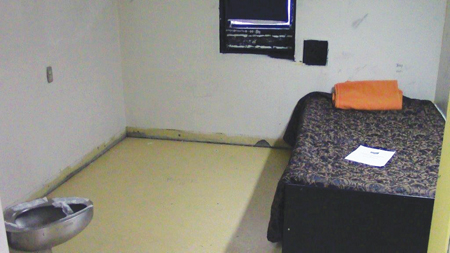
Photo of a segregation cell at a regional womens facility.
Key Findings
Lack of appropriate infrastructure
The most pressing and practical issue is the lack of infrastructure within the secure unit to support the unique needs and manage the risks of the women who are classified as maximum security. There are between two and four pods in the secure unit of each institution. This infrastructure creates significant impediments as staff must use modified routines or movements to manage heightened population tensions on the secure pods. For example, in all but one institution, women reported that they are subject to constant cell moves to deal with population management challenges, such as inter-personal issues on the pods. One woman reported moving 20 times in 22 months as a result of interpersonal issues. In numerous interviews, women stated that they fear reprimand by staff if they object to the constantly changing living arrangements. Moreover, in the absence of physical space, depending on the institution, it may not be possible to move a woman to another pod as a result of incompatibilities with other inmates.
Additional classification system for women on the secure unith
Women in maximum security are subject to a unique classification or level system Footnote 39 intended to manage their movements when they are off the secure unit, for example, to attend or access services such as health care, visits, programs and/or school. Approximately one quarter of the women interviewed were subject to some type of restraint for off-unit movement. Women reported being shackled in order to walk through the institution to health care appointments. One woman reported being shackled while walking up the stairs and another during her gynecology appointment.
Just as concerning was the fact that women reported turning down visits with their children because they did not want their children to see them in leg irons (shackles) or handcuffs during their visit. Women in one region were subject to strip searches Footnote 40 every time they returned to the Secure Unit following off-unit movement, despite being identified as a positive level 3 and 4. Footnote 41 It is a significant indignity for women to suffer the shame and humiliation that comes with wearing leg irons or being subjected to strip searches in order to access programs and services. In some regions, we found that women assigned to level 1 and 2 did not have access to education, programs, gym, or library as these services were deemed privileges afforded to level 3. The level system is a gender-based discriminatory restriction unique to the womens sites: male offenders are not subject to the same movement restrictions in order to access services and programs in the institution. Footnote 42 From the Offices perspective, the practice resembles the management of offenders in the Special Handling Unit (SHU) and is tantamount to the rescinded and illegal former Management Protocol. Footnote 43
- I recommend that the level system for maximum security women be rescinded. Without procedural safeguards and defined review dates, movement levels are arbitrary as they exist outside the law. Security requirements should be assessed on a case-by-case basis as per the principles outlined in the Corrections and Conditional Release Act.
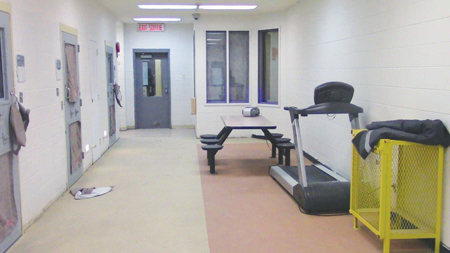
Photo of a segregation range for female inmates.
Impact of complex mental health cases in the secure unit
The Service is struggling to respond to the unique needs of the changing profile of women offenders. In their lifetime, the vast majority of federally sentenced women experience symptoms consistent with a psychiatric disorder. Footnote 44 A recent study identified that approximately half of all federally sentenced women had an active psychotropic prescription. Footnote 45 Women with mental health issues are more likely to be placed in maximum security. Footnote 46
CSC is managing an increasing number of complex mental health cases, many of whom reside on the secure unit. These women present with unique psychological needs such as major mental illness, personality disorder, cognitive impairment, learning disorder, substance abuse, trauma or any combination of these. A significant number of these women engage in chronic, repetitive self-injurious or suicidal behaviour. As of 2016, CSC was managing approximately 48 complex needs women who were identified and monitored at the regional or national level. Two of those women committed suicide on the Secure Unit within the past two years.
The Offices 2016 Annual Report contained a review of complex cases in the secure unit. At that time, the Office recommended that specialized complex case funding should not be used as an alternative to seeking placement in an external treatment facility. The impact of a complex mental health case living on a maximum security unit cannot be over-stated. Women consistently reported numerous consequences to their daily routine linked to the management of complex cases on the unit. For example:
- Women reported being routinely confined or locked up in their cell as security staff respond to the needs of complex cases in the maximum security unit. When the women are confined to their cell, interventions are cancelled. These lock-ups cause a great deal of frustration for the women and for the program and therapeutic staff who cannot provide their services.
- Some women reported that they do not mind going to segregation as it provides them some reprieve from living with women with acute mental health problems on the secure unit.
- Thirty five percent of the women reported feeling unsafe in the Secure Unit. Both women and staff voiced their concerns with the lack of support to respond to the needs of the women who have significant mental health problems. Ironically, in circumstances where the institution received additional funding to support a woman with complex mental health problems, the negative impact on the conditions of the confinement for the rest of the women was more pronounced.
Were affected by it, we all get locked down and were wondering if this person is okay, we can hear screaming, we can hear crying we know something is wrong. Its traumatic is what it is, its traumatic.
Woman at Secure Unit
The Hole: Impact of Segregation
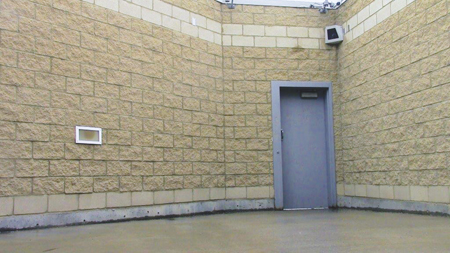
Photo of an outdoor segregation yard at a regional womens facility.
Ninety percent of the women interviewed for this investigation reported being segregated during their sentence. 83% also reported having mental health problems. Women in the Secure Unit who are placed in segregation lament the conditions there. Footnote 47 The cells are cold, dirty and isolated. The Office was informed by CSC staff in one region that women are provided earplugs while on clinical isolation to assist in coping with the screaming from other women in segregation, co-located on the same wing. The segregation unit is a familiar place for the women interviewed; one-quarter of the women reported having been under some form of mental health monitoring for self-harm or suicide watch during the last year. The investigation found that mental health problems were often exacerbated during their placement in segregation. Women reported feeling extremely anxious or paranoid while in segregation. In a few interviews, women discussed how they became suicidal during their stay in segregation. The segregation unit is not an appropriate environment for women who are under observation for mental health problems, especially suicidal or self-harming ideations.
Well, basically, its like being in a hole in the wall because thats what it is: its a cement hole in the wall... I started getting claustrophobia while I was in segregation. I started feeling like I couldnt breathe and um I actually tried to end my life in segregation. I tried to kill myself, I came very close... tried to hang I tried to kill myself...I almost died. I tried to take my own life...it literally, like, it destroys you. It literally destroys your spirit.
Woman at Secure Unit
Number of women interviewed participating in correctional programming
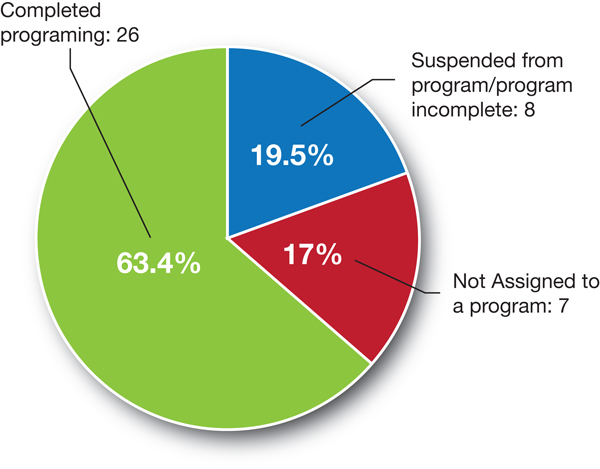
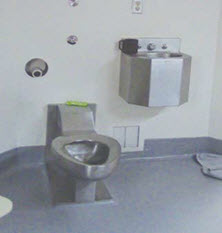
Photo of a segregation cell.
Absence of meaningful employment
The investigation found a general absence of meaningful employment for the women in Secure Units. Employment is limited to janitorial type work, such as floor or shower cleaner. The women indicated to the Office that they do not consider these jobs to be meaningful, but report wanting to work so that they may be permitted out of their cell or pod even if just for the 20 minutes it takes to complete their job. While women consistently reported being assigned to correctional programming, they indicated that programs are negatively affected by lock downs linked to disruptions on the pod (e.g., self-harm).
Of note, of the 26 women who completed their programming, 73% resided in only three of the five regional institutions. In one region, over 50% of the women were either suspended or were not assigned to a core program during the last fiscal year. Footnote 48 Similarly, while 15 women were enrolled in Dialectical Behaviour Therapy (DBT) Footnote 49 , five were from one regional site. While it is encouraging to see the level of participation in programming at a few regional sites, the Office found that women were overwhelmingly assigned or completed one program per year, lasting on average two or three months. Given the level of risk and need associated with women residing in the Secure Unit, the controlled environment of the unit could provide more meaningful interventions. On a more positive note, during the last fiscal year, the majority of the 49 educational assignments for the women interviewed were either being completed or had been completed.
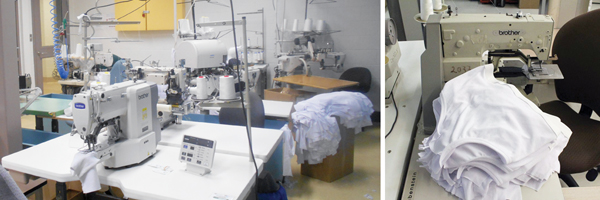
Photo: Female inmates at Joliette Institution make underwear for male inmates
in other federal penitentiaries
Photo credit: Standing Senate Committee on Human Rights
The few women (4) assigned to post-secondary studies report difficulties accessing the computer in order to complete their studies even though there was a computer physically located in the secure unit. Footnote 50 Staff also identified similar obstacles for the women who pursue secondary studies, noting that the women do not have access to secure accounts to save completed work. Given the opportunity, women would rather be constructively engaged.
On a positive note, this investigation provided a glimpse into the important and positive role that staff members can have on womens healing, counterbalancing some of the deleterious impacts of the secure environment. Many women expressed significant respect and appreciation for staff members who engaged in meaningful interaction, especially those perceived to have genuine concern for their well-being. Half of all women interviewed identified a helpful staff member who had supported them in their rehabilitation or assisted them in coping within the confines of their environment.
Conclusion
Seventy five percent of the women interviewed in the Secure Unit reported living with mental health problems. The vast majority of these women struggle to cope with their mental health problems in an environment that is far from conducive to treatment. The investigation illustrates the many ways in which the physical infrastructure of the Secure Unit and its operational policies and practices act as barriers to any improvement in the womens mental health. The issues identified in this investigation are deterrents to therapeutic interventions. The level system used to manage maximum security women exists outside the law. Despite the emphasis on compliance and control that dominates the correctional philosophy and the movement of the women in the Secure Unit, a significant number of women have reported that they do not feel safe in this environment.
As suggested by this investigation, some major shifts in thinking and practice are required in womens institutional corrections. First, women with acute mental illness should not be managed in a maximum security (Secure Unit) setting. Instead, these women should be transferred to a treatment facility to access a more appropriate therapeutic environment (see recommendation #3 of this report). Second, a self-injurious or suicidal woman should not be placed in the segregation unit for suicide watch or mental health observation purposes. This practice is unsafe and often exacerbates mental health problems; it can also lead to an escalation in self-harming or suicidal behaviours. Third, the Secure Units are highly restrictive and repressive environments. The close and cramped living arrangements lead to tension, frustration and conflicts among the women, many of whom also struggle with mental health issues. Finally, at least half of the women classified as maximum security and held in the Secure Units are Indigenous. These women are not fully benefiting from the range of services, programs and supports to which Indigenous people in federal custody are entitled under the law.
The issue comes down to whether women classified as maximum security must be physically separated and accommodated in the Secure Units or whether they can be integrated and managed as part of the general women inmate population. The Structured Living Environments (SLEs) in the regional facilities offer an alternative accommodation arrangement that includes an intermediate mental health care component and a higher level of staff presence. However, SLE bed and treatment capacity is limited and the need great. I believe that most maximum security women could be appropriately managed in SLEs, an approach that is more consistent with the philosophy and practice of womens corrections as articulated in Creating Choices. CSC has been able to reduce the segregation population in half by creating viable alternatives. For women offenders, the alternative to Secure Units is to build more SLE capacity.
- I recommend that CSC expand capacity of the Structured Living Environments to allow for women with mental health needs to be integrated and accommodated in more appropriate and therapeutic settings. The Secure Units should be limited to separating women who would otherwise normally be placed in segregation.
Correctional Investigators Outlook for 2017-18
Sharp reductions in the use of segregation and length of stays over the past two years serve as a reminder of what can be accomplished when the Correctional Service of Canadas leadership, focus and priority are fully engaged. The Service should be commended for these outcomes. Though no easy task, I am reminded that these results were achieved without any changes to legislation or regulatory amendments. Furthermore, they were accomplished without unduly compromising the safety and security of CSC institutions, staff or offenders. Without diminishing the effort or results, I remain convinced that legal reforms are required to ensure that these gains are sustained over time, to further reduce reliance on segregation (especially for offenders with significant mental health issues and who are suicidal or chronically self-injure, younger offenders and women) and to enhance due process and procedural safeguards consistent with Canadas domestic and international human rights obligations.
I am encouraged by the proposed legislation that was tabled in Parliament in June 2017. Presumptive release from segregation by 15 days and the external scrutiny of independent reviewers should have a significant impact on the number of inmates being segregated and the average length of stay. These measures will assist CSC in ensuring that administrative segregation beyond the 15 day limit is used only in rare and exceptional situations.
In the year ahead, I look forward to the Correctional Service investing a similar measure of focus and priority to address other equally persistent challenges in federal corrections. First, although I understand and appreciate that not all deaths in custody are preventable, there is, as the Matthew Hines case demonstrates, room to improve recognition and response to medical emergencies. Secondly, I anticipate seeing some sharp reductions in the overall use and reliance on chemical and inflammatory agents in use of force interventions. Introducing restraint in this area will not be easy, but changing the culture by reigning in the use of a weapon that runs counter to peaceful resolution of issues is both necessary and the right thing to do. Thirdly, the ongoing dysfunction of the internal inmate complaint and grievance system must be addressed.
Fourthly, in response to a recommendation in last years Annual Report, the Service agreed to develop a national older offender strategy to address the care and custody needs of offenders aged 50 or older. At that time, CSCs response indicated that it would begin developing the strategy over the course of 2016-17, to be completed in 2017-18. As time passes, I remain concerned that the needs of 25% of the inmate population are not being properly met or served. In the coming year, I fully expect my Office to be briefed and consulted on a comprehensive and responsive package of older offender initiatives that addresses an area of outstanding concern dating back to 2010/11, when this recommendation was first made.
Finally, it is my hope that the Government of Canada will proceed, without further delay, to sign and ratify the United Nations Optional Protocol to the Convention against Torture and other Cruel, Inhuman or Degrading Treatment or Punishment (OPCAT). This international convention, which has been signed by almost 100 countries, would uphold the fundamental human rights of all individuals held in detention in Canada. In meeting the terms of the treaty, there are considerable advantages in the federal government establishing a new single National Prevention Mechanism (NPM) for places of detention under federal authority (penitentiaries, immigration detention centres, RCMP cells, Canadian Forces Service Prison and Detention Barracks). The designated NPM could serve as a centre of national expertise and assistance for the provinces and territories as Canada moves toward full ratification of the treaty. There is a sense of urgency to sign the OPCAT as further delays have important human rights implications for individuals deprived of their liberty.
I look forward to working with the Correctional Service and the Government of Canada to realize more of the potential of effective corrections and the benefits of independent prison oversight.
Ivan Zinger, J.D., Ph. D
Correctional Investigator
Ed McIsaac Human Rights in Corrections Award

Photo of Ms. Elizabeth White, the 2016 recipient of the Ed McIsaac Human Rights in Corrections Award
with Mr. Howard Sapers, former Correctional Investigator of Canada.
Left to Right: Ms. Elizabeth White and Mr. Howard Sapers, former Correctional Investigator of Canada (December 6, 2016).
The Ed McIsaac Human Rights in Corrections Award was established in December 2008, in honour of Mr. Ed MsIsaac, long-time Executive Director of the Office of the Correctional Investigator and strong promoter and defender of human rights in federal corrections. It commemorates outstanding achievement and commitments to improving corrections in Canada and protecting the human rights of the incarcerated.
The 2016 recipient of the Ed McIsaac Human Rights in Corrections award was Elizabeth White, Executive Director of the St. Leonards Society of Canada.
Annex A: Summary of Recommendations
- I recommend that CSC review, in FY 2017-18, its health care policies, practices and authorities to ensure they are compliant with the revised United Nations Standard Minimum Rules for the Treatment of Prisoners (Nelson Mandela Rules), specifically those relating to health care services (Rules 24 to 35), solitary confinement (Rules 45 and 46) and instruments of restraint (Rules 47 to 49).
- I recommend that transferring mentally ill women in the Pacific Region to the all-male Regional Treatment Centre be absolutely and explicitly prohibited. Women requiring mental health treatment should be transferred to the female unit at the Regional Psychiatric Centre (RPC) in Saskatoon, or, preferably, to a local external community psychiatric hospital as required.
- I recommend that CSC issue a Request for Proposal to fund or expand community bed treatment capacity to accommodate up to 12 federally sentenced women requiring an intensive level of mental health intervention, care and supervision.
- I recommend that CSC reintroduce safe tattooing as a national program.
- I recommend that compassionate and humanitarian interests guide policy and practice in implementing Medical Assistance in Dying legislation in federal corrections. The decision of a palliative or terminally ill offender to end life through MAID should be freely and voluntarily made in the community.
- I recommend that the lessons learned from the National Board of Investigation into the December 2016 major disturbance at Saskatchewan Penitentiary be widely circulated within CSC and released as a public document.
- I recommend that an external audit and evaluation of CSC food services be conducted on a priority basis and that the concerns of the inmate population relating to portion size, quality, selection and substitution of food items be solicited, heard and addressed immediately by CSC management. The audit should include comparison of ration and per diem meal costs, prior to and after introduction of the food services modernization initiative.
- I recommend reinstatement and expansion of the Alternative Dispute Resolution pilot program at all medium and maximum security penitentiaries.
- I recommend that CSC publish on its public website the process for requesting use of force video recordings, including the legal criteria for exemptions and disclosure. CSC should inform the inmate population of their right to access use of force video recordings.
- I recommend that CSC conduct a review of its prison visitor program, to include an updated evaluation of the use and reliability of Ion Mobility Spectrometry devices, and report the results to the Canadian public.
- I recommend that, over the next two years, CSC remove the current fleet of security escort vehicles (small minivans) as their design is substandard and unsafe and replace them with larger vehicles meeting industry standards in policing (e.g. RCMP).
- I recommend that CSC review its community release strategy for Indigenous offenders with a view to:
- increase the number of Section 81 agreements to include community accommodation options for the care and custody of medium security inmates;
- address discrepancies in funding arrangements between CSC and Aboriginal-managed Healing Lodge facilities, and;
- maximize community interest and engagement in release planning for Indigenous offenders at the earliest opportunity.
- I recommend that the Minister of Public Safety request that the Standing Committee on Public Safety and National Security (SECU) conduct a special study on inmate work and prison industries (CORCAN).
- I recommend that the prison farm program be reinstated under CORCAN direction.
- I recommend reinstatement of the Lifeline program.
- I recommend that the level system for maximum security women be rescinded. Without procedural safeguards and defined review dates, movement levels are arbitrary as they exist outside the law. Security requirements should be assessed on a case-by-case basis as per the principles outlined in the Corrections and Conditional Release Act .
- I recommend that CSC expand capacity of the Structured Living Environments to allow for women with mental health needs to be integrated and accommodated in more appropriate and therapeutic settings. The Secure Units should be limited to separating women who would otherwise normally be placed in segregation.
Annex B: Annual Statistics
Table A: Complaints By Category
Internal Response - see Glossary (2), Inquiries and Investigations - see Glossary (3)
| CATEGORY | I/R(2) | Inv (3) | Total |
|---|---|---|---|
| Administrative Segregation | |||
| Conditions | 22 | 50 | 72 |
| Placement/Review | 70 | 116 | 186 |
| Total | 92 | 166 | 258 |
| Case Preparation | |||
| Conditional Release | 33 | 35 | 68 |
| Post Suspension | 4 | 10 | 14 |
| Temporary Absence | 2 | 8 | 10 |
| Transfer | 7 | 14 | 21 |
| Total | 46 | 67 | 113 |
| Cell Effects | 231 | 245 | 476 |
| Cell Placement | 28 | 27 | 55 |
| Claim | |||
| Decisions | 13 | 12 | 25 |
| Processing | 22 | 9 | 31 |
| Total | 35 | 21 | 55 |
| Community Programs/Supervision | 34 | 17 | 54 |
| Conditional Release | 6 | 6 | 12 |
| Conditions of Confinement | |||
| Behavioural Contract | 2 | 2 | 4 |
| Food Services | 10 | 9 | 19 |
| Lockdown | 25 | 54 | 79 |
| Special Units | 13 | 28 | 41 |
| Recreation Time | 16 | 22 | 38 |
| Smoking | 1 | 0 | 1 |
| Other | 277 | 237 | 514 |
| Total | 344 | 352 | 696 |
| Conviction/Sentence-Current Offence | 3 | 1 | 4 |
| Correspondence | 96 | 62 | 158 |
| Death or Serious Injury | 12 | 10 | 22 |
| Decisions (General) - Implementation | 19 | 15 | 34 |
| Diets | |||
| Medical | 11 | 13 | 24 |
| Religious | 11 | 17 | 28 |
| Total | 22 | 30 | 52 |
| Discipline | |||
| ICP Decisions | 5 | 5 | 10 |
| Minor Court Decisions | 4 | 5 | 9 |
| Procedures | 19 | 15 | 34 |
| Total | 28 | 25 | 53 |
| Discrimination | 8 | 12 | 20 |
| Double Bunking | 6 | 10 | 16 |
| Employment | 58 | 46 | 104 |
| Financial Matters | |||
| Access | 41 | 37 | 78 |
| Pay | 40 | 41 | 81 |
| Total | 81 | 78 | 159 |
| Food Services | 35 | 33 | 68 |
| Grievance | |||
| 3 rd Level Review | 30 | 19 | 49 |
| Decision | 15 | 6 | 21 |
| Procedure | 51 | 42 | 93 |
| Total | 96 | 67 | 163 |
| Harassment | 40 | 44 | 84 |
| Health and Safety - Inmate Worksites/Programs | 7 | 6 | 13 |
| Health Care | |||
| Access | 136 | 187 | 323 |
| Decisions | 61 | 81 | 142 |
| Dental | 26 | 39 | 65 |
| Medication | 138 | 136 | 274 |
| Methadone | 13 | 15 | 28 |
| Total | 374 | 458 | 832 |
| Hunger Strike | 2 | 8 | 10 |
| Immigration / Deportation | 0 | 1 | 1 |
| Information | |||
| Access/Disclosure | 86 | 40 | 126 |
| Correction | 51 | 31 | 82 |
| Total | 137 | 71 | 208 |
| Inmate Requests | 23 | 13 | 36 |
| IONSCAN | 7 | 2 | 9 |
| Legal Counsel - Access/Quality | 46 | 47 | 93 |
| Mental Health | |||
| Access/Programs | 22 | 35 | 57 |
| Quality | 4 | 9 | 13 |
| Self-Injury | 3 | 47 | 50 |
| Total | 29 | 91 | 120 |
| Methadone | 12 | 22 | 34 |
| Official Languages | 2 | 2 | 4 |
| Operation/Decisions of the OCI | 16 | 2 | 18 |
| Outside Court | 9 | 6 | 15 |
| Parole Decisions | |||
| Conditions | 35 | 14 | 49 |
| Day Parole | 22 | 21 | 43 |
| Detention | 6 | 7 | 13 |
| Full Parole | 7 | 8 | 15 |
| Revocation | 67 | 43 | 110 |
| Total | 137 | 93 | 230 |
| Uncategorized | 2 | 3 | 5 |
| Program/Services | |||
| Women | 4 | 4 | 8 |
| Aboriginals | 9 | 13 | 22 |
| Access | 48 | 38 | 86 |
| Decisions | 12 | 15 | 27 |
| Language Access | 3 | 1 | 4 |
| Other | 24 | 22 | 46 |
| Total | 100 | 92 | 193 |
| Provincial Matter | 6 | 1 | 7 |
| Release Procedures | 63 | 38 | 101 |
| Religious/ Spiritual | 15 | 23 | 38 |
| Safety / Security | |||
| Security of Offender | 52 | 63 | 115 |
| Incompatibles | 33 | 53 | 86 |
| Worksite | 4 | 4 | 8 |
| Total | 37 | 57 | 94 |
| Search and Seizure | 35 | 27 | 62 |
| Security Classification | 58 | 71 | 129 |
| Sentence Administration | 9 | 10 | 19 |
| Staff | 254 | 137 | 391 |
| Telephone | 98 | 81 | 179 |
| Temporary Absence | |||
| Escorted | 18 | 38 | 56 |
| Unescorted | 6 | 9 | 15 |
| Total | 24 | 47 | 71 |
| Temporary Absence Decision | 5 | 14 | 19 |
| Transfer | |||
| Implementation | 24 | 22 | 46 |
| Involuntary | 78 | 97 | 175 |
| Pen Placement | 13 | 31 | 44 |
| Section 81 / 84 | 1 | 2 | 3 |
| Voluntary | 66 | 88 | 154 |
| Total | 182 | 240 | 422 |
| Urinalysis | 13 | 16 | 29 |
| Use of Force | 25 | 51 | 76 |
| Visits | 121 | 147 | 268 |
| Uncategorized( * ) | 271 | ||
| Grand Total | 6768 | ||
[*] Includes: complaint topics not currently represented by the complaint categories outlined above, or complaints that address multiple categories at the same time.
Table B: Complaints By Institution / Region
| Region / Institution | Number of Complaints | Number of Interviews | Number of Days Spent in Institutions |
|---|---|---|---|
| FSW | |||
| Edmonton Women Facility | 132 | 68 | 8.5 |
| Fraser Valley | 78 | 36 | 6 |
| Grand Valley | 169 | 47 | 11 |
| Joliette | 158 | 77 | 8.5 |
| Nova | 102 | 35 | 6.5 |
| Okimaw Ohci Healing Lodge | 16 | 7 | 1 |
| Total | 655 | 270 | 41.5 |
| Atlantic | |||
| Atlantic | 293 | 104 | 13.25 |
| Dorchester | 237 | 43 | 10 |
| Shepody Healing Centre | 51 | 4 | 3 |
| Springhill | 104 | 31 | 7 |
| Total | 685 | 182 | 33.25 |
| Ontario | |||
| Bath | 192 | 62 | 10.5 |
| Beaver Creek | 150 | 50 | 9 |
| Collins Bay | 125 | 58 | 11.5 |
| Joyceville | 210 | 52 | 9 |
| Millhaven | 159 | 54 | 10 |
| RTC Bath / Millhaven | 55 | 17 | 2.5 |
| Warkworth | 236 | 68 | 13 |
| Total | 1127 | 361 | 66.5 |
| Pacific | |||
| Kwikwxwelhp | 1 | 0 | 1 |
| Kent | 209 | 91 | 15 |
| Matsqui | 240 | 70 | 7 |
| Mission | 179 | 66 | 8 |
| Mountain | 317 | 149 | 10 |
| Pacific/RTC | 191 | 87 | 6 |
| William Head | 26 | 77 | 2 |
| Total | 1163 | 380 | 49 |
| Prairies | |||
| Bowden | 150 | 47 | 7.5 |
| Drumheller | 147 | 42 | 7 |
| Edmonton | 280 | 64 | 12 |
| Grande Cache | 86 | 21 | 9 |
| Grierson Centre | 4 | 2 | 0.5 |
| Stan Daniels | 2 | 0 | 0.5 |
| P Skstw | 19 | 24 | 1 |
| RPC - Prairies | 322 | 32 | 4.5 |
| Saskatchewan Penitentiary | 400 | 106 | 11.5 |
| Stony Mountain | 230 | 108 | 10 |
| Riverbend | 1 | 0 | 0 |
| Willow Cree | 3 | 20 | 1.5 |
| Total | 1660 | 466 | 65 |
| Qubec | |||
| Archambault | 173 | 41 | 9.5 |
| Archambault CRSM | 10 | 12 | 5 |
| Cowansville | 89 | 52 | 10.5 |
| Donnacona | 183 | 76 | 12 |
| Drummond | 70 | 37 | 8.5 |
| Federal Training Centre | 185 | 67 | 11 |
| La Macaza | 120 | 68 | 10 |
| Port Cartier | 158 | 114 | 16 |
| RRC Qubec | 142 | 57 | 12 |
| SHU - USD | 39 | 23 | 12 |
| Waseskun Healing Lodge | 7 | 3 | 0.5 |
| Total | 1176 | 550 | 107 |
| CCC/CRC/ Parolees in Community | 289 | 0 | 0 |
| Federal Inmates in Provincial Institutions | 8 | 0 | 0 |
| Uncategorized | 21 | ||
| Grand Total | 6768 | 2183 | 361.25 |
Table C: Complaints and Inmate Population - by Region
| Region | Total Number of Complaints | Inmate Population ( * ) |
|---|---|---|
| Atlantic | 685 | 1248 |
| Quebec | 1176 | 2993 |
| Ontario | 1127 | 3368 |
| Prairie | 1660 | 3863 |
| Pacific | 1163 | 2046 |
| Womens Facilities | 639 | 693 |
| CCC/CRC/Community/Provincial Facilities | 297 | N/A |
| Uncategorized | 21 | N/A |
| Grand Total | 6768 | 14211 |
[*] Inmate Population broken down by Region: As of March 29,2016, according to the Correctional Service of Canadas Corporate Reporting System.
Table D: Disposition of Complaints by Action
| Action | Disposition | Number of Complaints |
|---|---|---|
| Internal Response | ||
| Advise/Information Given | 2122 | |
| Assisted by Institution | 189 | |
| Pending | 4 | |
| Recommendation | 2 | |
| Refer to Grievance Process | 148 | |
| Refer to Institutional Staff | 496 | |
| Refer to Warden | 60 | |
| Rejected as unfounded | 122 | |
| Systemic/Multiple | 16 | |
| Withdrawn | 61 | |
| Uncategorized | 91 | |
| Total | 3311 | |
| Inquiry | ||
| Advise/Information Given | 891 | |
| Assisted by Institution | 1069 | |
| Pending | 9 | |
| Recommendation | 23 | |
| Refer to Grievance Process | 108 | |
| Refer to Institutional Staff | 365 | |
| Refer to Warden | 150 | |
| Rejected as unfounded | 130 | |
| Systemic/Multiple | 53 | |
| Withdrawn | 18 | |
| Uncategorized | 83 | |
| Total | 2902 | |
| Investigation | ||
| Advise/Information Given | 79 | |
| Assisted by Institution | 160 | |
| Pending | 5 | |
| Recommendation | 23 | |
| Refer to Grievance Process | 6 | |
| Refer to Institutional Staff | 20 | |
| Refer to Warden | 31 | |
| Rejected as unfounded | 60 | |
| Systemic/Multiple | 61 | |
| Withdrawn | 11 | |
| Uncategorized | 99 | |
| Total | 555 | |
| Grand Total | 6768 | |
Table E: Areas of Concern Most Frequently Identified by Offenders
Total Offender Population
| Category | # | % |
|---|---|---|
| Health Care | 868 | 12.75% |
| Conditions of Confinement | 743 | 10.91% |
| Cell Effects | 495 | 7.27% |
| Transfer | 438 | 6.43% |
| Staff | 405 | 5.95% |
| Administrative Segregation | 269 | 3.95% |
| Parole Decisions | 241 | 3.54% |
| Information | 213 | 3.13% |
| Telephone | 182 | 2.67% |
| Grievance | 171 | 2.51% |
Aboriginal Offenders
| Category | # | % |
|---|---|---|
| Conditions of Confinement | 111 | 11.96% |
| Health Care | 101 | 10.88% |
| Cell Effects | 80 | 8.62% |
| Staff | 64 | 6.90% |
| Transfer | 58 | 6.25% |
| Administrative Segregation | 56 | 6.03% |
| Mental Health | 36 | 3.88% |
| Parole Decisions | 28 | 3.02% |
| Telephone | 25 | 2.69% |
| Financial Matters | 24 | 2.37% |
Women Offenders
| Category | # | % |
|---|---|---|
| Conditions of Confinement | 123 | 17.20% |
| Health Care | 82 | 11.47% |
| Cell Effects | 46 | 6.43% |
| Staff | 45 | 6.29% |
| Mental Health | 37 | 5.17% |
| Administrative Segregation | 32 | 4.48% |
| Visits | 27 | 3.77% |
| Temporary Absence | 24 | 3.36% |
| Security Classification | 22 | 3.08% |
| Parole Decisions | 22 | 3.08% |
Annex C: Other Statistics
A. Mandated Reviews Conducted in 2015-16
As per the Corrections and Conditional Release Act (CCRA) , the Office of the Correctional Investigator reviews all CSC investigations involving incidents of inmate serious bodily injury or death.
Mandated Reviews by Type of Incident
| Assault | 53 |
| Murder | 2 |
| Suicide | 8 |
| Attempted Suicide | 5 |
| Self-Harm | 5 |
| Injuries (Accident) | 12 |
| Overdose Interrupted | 14 |
| Death (Natural Cause) * | 16 |
| Death (Unnatural Cause) | 2 |
| Other ** | 2 |
| Total | 119 |
[*] Deaths due to natural causes are investigated under a separate Mortality Review process involving a file review conducted at National Headquarters.
[**] Investigations convened under S. 97 & 98 of the CCRA, including disturbances, sexual assault, etc.
B. Use of Force Reviews Conducted by the OCI in 2015-16
Per policy, the Correctional Service is required to provide all pertinent and relevant use of force documentation to the Office. Use of force documentation typically includes:
- Use of Force Report,
- Copy of incident-related video recording,
- Checklist for Health Services Review of Use of Force,
- Post-incident Checklist,
- Officers Statement/Observation Report; and,
- Action plan to address deficiencies.
OCI Use of Force Statistics for 2015-2016
| Atlantic Region | Quebec Region | Ontario Region | Prairie Region | Pacific Region | Federally Sentenced Women | National | |
|---|---|---|---|---|---|---|---|
| Reported incidents reviewed by the OCI | 104 | 337 | 271 | 438 | 150 | 136 | 1436 |
Use of force measures applied
| Atlantic Region | Quebec Region | Ontario Region | Prairie Region | Pacific Region | Federally Sentenced Women | Total | |
|---|---|---|---|---|---|---|---|
| Emergency Response Team | 14 | 21 | 41 | 13 | 2 | 7 | 98 |
| Verbal intervention | 101 | 280 | 227 | 427 | 146 | 123 | 1304 |
| Physical Handling | 73 | 200 | 210 | 308 | 132 | 112 | 1035 |
| Restraint equipment | 21 | 258 | 186 | 274 | 88 | 84 | 911 |
| Use of OC (Inflammatory Agent) | 67 | 218 | 138 | 276 | 86 | 67 | 852 |
| Use of CS (Chemical Agent) | 0 | 19 | 1 | 0 | 0 | 0 | 20 |
| Distraction Device | 0 | 0 | 0 | 3 | 1 | 1 | 5 |
| Shield | 4 | 18 | 30 | 29 | 5 | 11 | 97 |
| Baton | 0 | 2 | 10 | 5 | 3 | 3 | 23 |
| Display/Charging firearm | 2 | 1 | 0 | 13 | 0 | 0 | 16 |
| Use of firearm-warning shot | 2 | 3 | 0 | 4 | 1 | 0 | 10 |
| Use of firearm aimed shot | 0 | 0 | 0 | 0 | 0 | 0 | 0 |
Indicators of concerns
| Atlantic Region | Quebec Region | Ontario Region | Prairie Region | Pacific Region | Federally Sentenced Women | Total | |
|---|---|---|---|---|---|---|---|
| Aboriginal | 29 | 62 | 42 | 192 | 26 | 58 | 409 |
| Women | 42 | 14 | 29 | 69 | 11 | 165 | |
| Mental Health Issues identified (CSC) | 49 | 85 | 118 | 164 | 38 | 94 | 548 |
Injuries
| Atlantic Region | Quebec Region | Ontario Region | Prairie Region | Pacific Region | Federally Sentenced Women | Total | |
|---|---|---|---|---|---|---|---|
| Injuries to offender | 0 | 57 | 35 | 10 | 7 | 5 | 114 |
C. Toll-Free Contacts in 2016-17
Offenders and members of the public can contact the OCI by calling our toll-free number (1-877-885-8848) anywhere in Canada. All communications between offenders and the OCI are confidential.
Number of toll-free contacts received in the reporting period: 22,282
Number of minutes recorded on toll-free line: 98,332
D. National Level Investigations in 2016-17
- In the Dark: An Investigation of Death in Custody Information Sharing and Disclosure Practices in Federal Corrections (August 2, 2016)
- Fatal Response. An Investigation into the Preventable Death of Matthew Ryan Hines , (February 15, 2017). Special Report to Parliament, (May 2, 2017)
E. Web Statistics
Total Page Views: 7,626,056
Visitors: 349,783
Response of the Correctional Service of Canada to the 44 th Annual Report of the Correctional Investigator 2016-2017
INTRODUCTION
The Correctional Service of Canada (CSC) contributes to the maintenance of a just, peaceful and safe society by carrying out sentences imposed by the courts and ensuring the safe and humane custody and supervision of offenders. CSC also encourages and assists the rehabilitation of offenders and their reintegration into the community as law-abiding citizens through the provision of programs in penitentiaries and in the community.
On a typical day during 2016-17, CSC was responsible for 22,882 offenders, of whom 14,310 were in federal custody (including temporary detainees) and 8,572 were supervised in the community. CSC is responsible for the management of 43 institutions, 91 parole offices and 15 community correctional centres. CSC has nine (9) Healing Lodges to support the reintegration of Indigenous offenders into the community, four (4) of which are managed by CSC in close collaboration with Indigenous communities (included in the 43 institutions). The remaining five (5) are managed by Indigenous communities under Section 81 of the CCRA. As well, CSC operates six learning centres across the country and CSC employs over 18,000 people.
Recent years have seen significant changes to CSCs operational environment and this is expected to continue into the foreseeable future. CSC is supporting the governments mandate to address gaps in services, throughout the criminal justice system, for Indigenous Peoples and those with mental illness. At the same time, the Government of Canadas Budget 2017 has provided funding to modernize the federal correctional system by supporting the rehabilitation and reintegration of Indigenous offenders, and expanding mental health supports.
Throughout 2016-17, CSC took numerous actions in response to audits of the Office of the Auditor General of Canada as well as reports from the Office of the Correctional Investigator. In this regard, CSC has achieved a number of successes in 2016-17, including a higher number of offenders returning safely and successfully to the community, a significant decrease in the number of offenders who are in administrative segregation or double-bunked, more treatments of Hepatitis C and opiate addiction, reductions in non-natural deaths in custody and a declining incarcerated population.
CSCs enduring priorities are:
- Safe management of eligible offenders during their transition from the institution to the community, and while on supervision.
- Safety and security of the public, victims, staff and offenders in institutions and the community.
- Effective, culturally appropriate interventions and reintegration support for First Nations, Mtis and Inuit offenders.
- Effective and timely interventions in addressing mental health needs of offenders
- Efficient and effective management practices that reflect values-based leadership in a changing environment.
- Productive relationships with diverse partners, stakeholders, victims' groups, and others involved in support of public safety.
This is a time of immense change within CSC and consequently the Service welcomes the report of the Correctional Investigator. CSC will continue to work closely with the Office of the Correctional Investigator to address and resolve issues of mutual concern raised in this report, in pursuit of its mandate and in the interest of public safety for Canadians.
HEALTH CARE IN FEDERAL CORRECTIONS
- I recommend that CSC review, in FY 2017-18, its health care policies, practices and authorities to ensure they are compliant with the revised United Nations Standard Minimum Rules for the Treatment of Prisoners (Nelson Mandela Rules) , specifically those relating to health care services (Rules 24 to 35), solitary confinement (Rules 45 and 46) and instruments of restraint (Rules 47 to 49).
CSC is reviewing its health care policies to ensure compliance with the Nelson Mandela Rules. This review is expected to be completed by March 31, 2018.
CSCs work is ongoing with respect to implementing important changes in relation to health care policies, including those pertaining to health care services, administrative segregation and restraints. Amongst the changes to these policies, there are specific groups of inmates who are not admissible to administrative segregation, as well as additional groups that are not admissible unless exceptional circumstances are identified.
In addition, the conditions of confinement in administrative segregation have been enhanced to ensure the allowance of essential items upon admission, personal property within 24 hours, daily showers, and a minimum of two hours daily outside of the inmates cell.
Prior to any admission to administrative segregation, health professionals are currently consulted as part of the standard requirements prescribed in policy. Upon admission, assessments by health care professionals continue to occur on a daily basis to identify any noted concerns, including the deterioration of the mental health of the inmate.
The proposed enhancements related to conditions of confinement, as well as the current practice of prohibiting offenders with certain mental or physical disabilities from being admitted to administrative segregation are consistent with the Nelson Mandela Rules.
- I recommend that transferring mentally ill women in the Pacific Region to the all-male Regional Treatment Centre be absolutely and explicitly prohibited. Women requiring mental health treatment should be transferred to the female unit at the Regional Psychiatric Centre (RPC) in Saskatoon, or preferably, to a local external community psychiatric hospital as required.
CSC fully supports the recommendation to provide hospital level care for mentally ill women at local external community psychiatric hospitals. Access to local community psychiatric hospital beds for federally incarcerated women would enhance the continuum of mental health services for this population and minimize the womens dislocation from their home communities and supports.
In the interim, as CSC continues to engage its health partners across the country and in order to ensure women are provided care in the most therapeutic environment possible, in fall 2017, CSC will enshrine in policy the requirement to use Regional Treatment Centres (RTCs) for women only in emergency circumstances and only for short-term periods. CSC will further require that these placements be done on the recommendation of the treating physician and that any woman placed at RTCs will be monitored by both the regional and national complex mental health committees. All efforts will be made to minimize the number of transfers while attempting to keep individuals close to their home community.
- I recommend that CSC issue a Request for Proposal to fund or expand community bed treatment capacity to accommodate up to 12 federally sentenced women requiring an intensive level of mental health intervention, care and supervision.
CSC recognizes the need to provide essential mental health services to women offenders and is committed to working with community partners to provide that care.
As a first step, CSC has engaged an external expert to identify and quantify womens mental health needs through a comprehensive mental health prevalence study. This research is nearing completion.
As a next step, CSC will engage external expertise to recommend what additional capacity is required. This work will be based on the results of the prevalence study and will take into consideration existing internal and external mental health service delivery capacity. This work will be completed no later than March 2018.
That said, CSC recognizes that it cannot wait for the results of this review to continue to improve women offenders access to care. As mentioned earlier, CSC will continue to engage local community psychiatric hospitals in order to improve access to intensive in-patient care close to the women offenders home communities and supports.
- I recommend that CSC reintroduce safe tattooing as a national program.
CSC will re-examine all possible harm reduction initiatives, including a safe tattooing program in 2017-18. CSC will continue to provide a broad continuum of disease prevention initiatives including treatment, health promotion, and harm reduction approaches related to infectious diseases.
- I recommend that compassionate and humanitarian interests guide policy and practice in implementing Medical Assistance in Dying legislation in federal corrections. The decision of a palliative or terminally ill offender to end life through MAID should be freely and voluntarily made in the community.
CSCs policy on Medical Assistance in Dying (MAID) will conform to the legislative requirements in this regard and will be guided by compassionate and humanitarian principles as well as applicable public safety legislative obligations. The policy is expected to be promulgated in November 2017.
CONDITIONS OF CONFINEMENT
- I recommend that the lessons learned from the National Board of Investigation into the December 2016 major disturbance at Saskatchewan Penitentiary be widely circulated within CSC and released as a public document.
CSC will develop a Lessons Learned Bulletin in order to share any lessons learned / best practices identified by the Board of Investigation (BOI) into the Saskatchewan Penitentiary riot. A summary of the investigation into the major disturbance at Saskatchewan Penitentiary will also be widely circulated within CSC and will be released as a public document in December 2017.
- I recommend that an external audit and evaluation of CSC food services be conducted on a priority basis and that the concerns of the inmate population related to portion size, quality, selection and substitution of food items are solicited, heard and addressed immediately by CSC management. The audit should include comparison of ration and per diem meal costs, prior to and after introduction of the food services modernization initiative.
An Internal Audit of Food Services is planned for fiscal year 2017-18, and is to be published during the second half of 2018. Upon developing the objectives and scope of the audit in the coming months, CSC will take the OCI's recommendation into consideration.
- I recommend reinstatement and expansion of the Alternative Dispute Resolution pilot program at all medium and maximum security penitentiaries.
Consistent with Alternative Dispute Resolution (ADR) and, as required by section 74(2) of the Corrections and Conditional Release Regulations, CSC supports and encourages staff and offenders at all sites to make every effort to resolve issues informally through discussion.
In order to ensure that CSC complies with section 90 of the CCRA, it has become imperative that the backlog and complexity of offender grievances at the national level be addressed on a priority basis. In this context, the ADR pilot program has been temporarily halted for 2017-18; however, CSC will be examining the lessons learned from the ADR pilot project and developing a model that is more efficient, effective, and accessible to all inmates. A new model will be developed in 2018-2019 and presented for possible consideration as part of legislative amendments.
- I recommend that CSC publish on its public website the process for requesting use of force video recordings, including the legal criteria for exemptions and disclosure. CSC should inform the inmate population of their right to access use of force video recordings.
CSC is currently examining the issue of disclosure of a video recording in the context of a disciplinary hearing, including the criteria for exceptions under the common law, public-interest privilege. As such, access to use of force video recordings will also be included in this review due to be completed by March 2018.
- I recommend that CSC conduct a review of its prison visitor program, to include an updated evaluation of the use and reliability of Ion Mobility Spectrometry devices, and report t h e results to the Canadian public.
CSC will review CD 566-8, Searching of Staff and Visitors in consultation with the Security Intelligence Officer Working Group to identify potential areas for improvement. As well, CSC will be conducting a review of the use and reliability of Ion Mobility Spectrometry devices, with an anticipated completion date of January 2018. The results of the review will be released as a public document.
- I recommend that, over the next two years, CSC remove the current fleet of security escort vehicles (small mini-vans) as their design is substandard and unsafe and replace them with larger vehicles meeting industry standards in policing (e.g. RCMP).
CSC is committed to replacing its fleet of security escort vehicles to reflect recent industry advancements in their design and configuration, while ensuring the safety and security of the public, staff, and offenders is maintained.
To this end, CSC will explore the purpose-built security escort vehicles currently in use by the RCMP as a potential option for replacement of CSCs vehicles in the future. This work will be undertaken in 2017-18, in addition to a review of factors impacting the life cycle of the existing fleet (age, mileage, overall condition of vehicles), which will inform next steps and timeframes for replacement of CSCs security escort vehicles.
INDIGENOUS CORRECTIONS
- I recommend that CSC review its community release strategy for Indigenous offenders with a view to:
i. increase the number of Section 81 agreements to include community accommodation options for the care and custody of medium security inmates;
The Service is committed to expanding Section 81 capacity to better accommodate the Indigenous offender population. As part of its efforts in this regard, and based on statements of interest from Indigenous communities, CSC is currently reviewing a number of such statements of interest in close collaboration with the community.
Given that Healing Lodges for male offenders are minimum-security environments, measures are currently being implemented to maximize the use of Healing Lodges as a critical step towards the successful reintegration of Indigenous male offenders to the community. CSC is enhancing its discretionary release processes through the creation of Indigenous Intervention Centres (AIC) to ensure that minimum-security offenders are transferred or pen-placed at a Healing Lodge in order to improve their opportunity for a safe and timely discretionary release into the community.
In the case of Indigenous women offenders, CSC is currently assessing the feasibility of increasing Healing Lodges access to Indigenous medium- and minimum-security women offenders in the Prairie Region including increasing bed capacity among the existing Healing Lodges. This will assist the Service in meeting the unique needs of Indigenous women offenders and provide them with increased opportunities to connect with their communities as they transition back into society as law-abiding citizens.
ii. address discrepancies in funding arrangements between CSC and Aboriginal-managed Healing Lodge facilities, and;
CSC values its working relationships with Indigenous communities and considers Indigenous-managed Healing Lodge facilities to be integral to the provision of Indigenous correctional services to Indigenous offenders. CSC and its Section 81 Agreement Holders, at mutually agreed upon times, conduct reviews, evaluations and negotiations related to the provision of services including security operations, case management and corresponding financial provisions. CSC will collaborate with its Section 81 Agreement Holders to examine funding arrangements with Indigenous-managed Healing Lodges for the purposes of maximizing its benefits to inmates while ensuring the efficient administration of Section 81 Agreements.
iii. maximize community interest and engagement in release planning for Indigenous offenders at the earliest opportunity.
As part of its commitment to transform Indigenous Corrections, CSC is currently implementing Aboriginal Intervention Centres (AIC), in each of its five regions. This is one of the critical initiatives to strengthen case management practices, respond to the needs of Indigenous offenders and foster the timely planning of Indigenous offenders correctional/healing plan, including the development of a preliminary release plan while at intake. Aboriginal Community Development Officers will be assigned to the AICs to ensure maximum use of Section 84 release planning process, and by extension, increase the participation of Indigenous communities in planning the release of Indigenous offenders. As CSC implements these Centres, lessons learned will be integrated to determine potential for expansion and enhancement.
SAFE AND TIMELY COMMUNITY REINTEGRATION
- I recommend that the Minister of Public Safety request that the Standing Committee on Public Safety and National Security (SECU) conduct a special study on inmate work and prison industries (CORCAN).
A study by the Public Safety and National Security Committee (SECU) on inmate work and prison industries would allow for more in-depth consideration of the pertinent operational, policy and financial implications related to this matter.
It should be noted that SECU initially discussed the CORCAN program at a hearing on February 27, 2015. During this meeting, CSCs Commissioner, Don Head, described the program, its goals, and challenges. Commissioner Head also suggested some ways that the Committee could be helpful to the program in specific areas, and he answered Committee members questions with respect to employment and skills training for offenders.
I have written to the Chairperson of SECU to formally advise him of this recommendation and to support a special study on CORCAN.
- I recommend that the prison farm program be reinstated under CORCAN direction.
In 2016, CSC conducted a community consultation and survey, with a feasibility study commencing thereafter and ongoing at this time. A Farm Advisory Panel, including seven (7) community members held its first meeting in June 2017. Additional meetings are ongoing and CSC is reviewing options related to re- opening of the farms at Collins Bay and Joyceville Institutions. CSC will submit its report to the Minister of Public Safety and Emergency Preparedness in the fall of 2017.
- I recommend reinstatement of the LifeLine program.
CSC is committed to addressing the unique needs of offenders serving a life sentence and offering targeted programs that provide appropriate support for all offenders as they work towards their rehabilitation. The Lifer Resource Strategy, which replaced the Lifeline Program, is available in all institutions. It includes 15 modules that are tailored to each stage of a life sentence: adaptation, integration, preparation for release, and release into the community. The Lifer Resource Strategy is designed to provide a standardized approach to supporting and managing life-sentenced offenders in a way that recognizes their specific circumstances and complements other programs and interventions provided by CSC staff. It is available alongside many other services offered by CSC including psychology, chaplaincy, community partners and numerous stakeholders, to support successful reintegration of long-term offenders.
FEDERALLY SENTENCED WOMEN
- I recommend that the level system for maximum security be rescinded. Without procedural safeguards and defined review dates, movement levels are arbitrary as they exist outside the law. Security requirements should be assessed on a case-by-case basis as per the principles outlined in the Corrections and Conditional Release Act .
CSC will conduct a review of the level system currently outlined in Commissioners Directive 578, Intensive Intervention Strategy in Women Offender Institutions/Units. This will include internal and external consultations to ensure that procedures are in full compliance with legislation and CSC policy, while also ensuring that women housed in Secure Units continue to have access to services, programs and activities in the main areas of the institutions, and that measures are in place to maintain the safety and security of other offenders and staff. Consultations are expected to be completed by January 2018, followed by the development of options and an implementation plan by March 2018.
- I recommend that CSC expand capacity of the Structured Living Environments to allow for women with mental health needs to be integrated and accommodated in more appropriate and therapeutic settings. The Secure Units should be limited to separating women who would otherwise normally be placed in segregation.
CSC fully supports the importance of a therapeutic environment for women offenders with significant mental health needs.
In this regard, further to Budget 2017, all womens mainstream institutions will receive additional funding to support mental health interventions for women in the Secure Unit. The timelines for the distribution of funds will be determined jointly by the Women Offender Sector and the Mental Health Branch.
Furthermore, in order to ensure CSC has the capacity required to meet the mental health needs of women at all security levels and, as noted in Recommendation 3, CSC will engage an independent external mental health professional to identify what additional mental health capacity is required and at what security level. This review will be completed no later than March 2018.
Footnote 1
The UN Standard Minimum Rules for the Treatment of Prisoners (SMRs) were first adopted in 1957. They were significantly revised and unanimously adopted by the UN General Assembly as the Nelson Mandela Rules in December 2015. Canada participated in the exercise to update and revise the Standard Minimum Rules.
Footnote 2
For a discussion, see Essex Paper 3: Initial Guidance on the Interpretation and Implementation of the UN Nelson Mandela Rules , Penal Reform International and the Essex Human Rights Centre, Essex University, 2017.
Footnote 3
These issues have been extensively documented in successive Annual Reports and investigations since 2009-10 and include the case of Ashley Smith ( A Preventable Death , March 2009); chronic self-injury among federally sentenced women ( Risky Business , September 2013); and, prison suicide ( A Three Year Review of Federal Inmate Suicides 2011-2014 , September 2014).
Footnote 4
Commissioners Directive 843 ( Management of Inmate Self-Injurious and Suicidal Behaviour ), February 2017.
Footnote 5
CSC already has policy guidelines entitled Physical Restraints for Medical Purposes that specifically apply to patients at the Regional Treatment Centres.
Footnote 6
Significantly, in the course of the review that led to the revised Mandela Rules, the use of instruments of restraint on medical grounds was deleted in recognition of the fact that health-care personnel are not to play any role in the application of any restrictive measures, including instruments of restraint. However, health care staff have an additional and positive duty of care to monitor and report, without delay, to the Prison Director (Warden) if they feel it necessary to terminate or alter the use of restraints for physical or mental health reasons. These considerations are not reflected in CSC policy.
Footnote 7
Where feasible, the Warden or his/her designate is supposed to consult with a health care professional when authorizing the application, reduction of use or removal of the Pinel Restraint System.
Footnote 8
The Assiniboine Unit (20 beds) is a physically separated female unit/wing within the larger, predominantly male Regional Psychiatric Centre (RPC) complex in Saskatoon. Interventions and participation in programs and other activities for the women housed there are strictly regulated by the prevailing conditions, movement and routines established for the male patients at RPC.
Footnote 9
Since May 2004, CSC has had a partnership with LInstitut Philippe-Pinel in Montreal (IPMM) for twelve beds for federally sentenced women offenders.
Footnote 10
For more information see Collins, P., Dias, G., Dickenson, M., Lines, R. and Vidovich, L. (2003). Driving the Point Home: A Strategy for Safer Tattooing in Canadian Prisons.
Footnote 11
CSC Data Warehouse, April 25, 2017.
Footnote 12
Public Health Agency of Canada, The Effectiveness of Bleach in the Prevention of Hepatitis C Transmission (2004).
Footnote 13
The Office understands that the obligation to ensure that the patient fully understands, voluntarily requests and meets the eligibility criteria rests with the medical or nurse practitioner. Notwithstanding, issues involving free, voluntary and informed consent are magnified in a correctional setting, as the person seeking medical assistance in dying is still under sentence (and therefore subject to control and supervision even while residing in the community).
Footnote 14
Following the release of the Offices report, it was necessary to once again bring forward two cases to CSC where one family was not provided a cause of death (the family only found out through the media following a leak) despite having preliminary information identifying a cause. In a second case, a family received two letters with conflicting information regarding the funeral costs.
Footnote 15
Arnen Boin, William Rattray, Understanding Prison Riots: Toward a Threshold Theory, Punishment and Society, Volume 6:1 (2004).
Footnote 16
Life in Prison: Food, A Findings Paper by HM Inspectorate of Prisons (July 2016), accessed at: https://www.justiceinspectorates.gov.uk/hmiprisons/wp-content/uploads/sites/4/2016/09/Life-in-prison-Food-Web-2016.pdf
Footnote 17
The average age of men incarcerated in federal penitentiaries is 37.
Footnote 18
Nigel Newcomen, Annual Report 2015-16, Prisons and Probation Ombudsman, accessed at: http://www.ppo.gov.uk/document/annual-reports/
Footnote 19
CSC correspondence to the OCI dated April 19, 2017. This average does not include the approximately 5,000 submissions related to the inmate telephone system received in 2014-15.
Footnote 20
CSC Quarterly Status Report: Q1 FY 2016-17.
Footnote 21
CSC, Internal Audit Sector, Status Report on Administrative Segregation, December 8, 2016.
Footnote 22
CSC/PBC Data Warehouse.
Footnote 23
CSC, Research in Brief: Monitoring Flows and Turnover Rates in Administrative Segregation; Trends in Administrative Segregation 2014 to 2016 and; Examining Time Spent in Administrative Segregation (June 2016).
Footnote 24
See, National Preventive Mechanism for the United Kingdom, Guidance: Isolation in Detention, (January 2017).
Footnote 25
The Essex Group defines the term meaningful human contact as direct rather than mediated, continuous rather than abrupt, and must involve genuine dialogue. The term requires the contact to be face to face and direct (without physical barriers). It must be more than fleeting or incidental. The Group has emphasized that it does not constitute meaningful human contact if prison staff deliver a food tray, mail or medication to the cell door or if prisoners are able to shout at each other through cell walls or vents.
Footnote 26
The percentage of positive random urinalysis results over the past five years has fluctuated between 5.6% and 6.3%. Source: CSC Performance Corporate Reporting System Modernized.
Footnote 27
CSC claims that the inserts are not fitted with seatbelts to ensure the security of correctional officers i.e., staff do not have to be in direct contact with inmates when getting into or out of the inserts. The front seats are equipped with seatbelts and airbags.
Footnote 28
By contrast, the number of Caucasian offenders has decreased by 14.7% over this same period.
Footnote 29
See, Office of the Correctional Investigator, Spirit Matters: Aboriginal People and the Corrections and Conditional Release Act (March 2013) at www.oci-bec.gc.ca
Footnote 30
2016 Fall Reports of the Auditor General of Canada: Report 3 Preparing Indigenous Offenders for Release Correctional Service Canada. http://www.oagbvg.gc.ca/internet/English/parl_oag_201611_e_41802.html
Footnote 31
CSC, Research Report, Profile of Aboriginal Offender Warrant of Committal Admissions to Federal Custody , (June 2015).
Footnote 32
CSC, 2016-17 Report on Plans and Priorities .
Footnote 33
Updated data for this section was extracted from the CSC/PBC Data Warehouse on 2017-02-20.
Footnote 34
In 2013, the UN Special Rapporteur on the Rights of Indigenous People visited Canada.
Footnote 35
See http://www.ohchr.org/EN/NewsEvents/Pages/DisplayNews.aspx?NewsID=20732&LangID=E for more information.
Footnote 36
Maximum security women live in the Intensive Intervention Unit (IIU), the building that houses them. This unit is also referred to as the secure unit. The secure unit is divided into pods of 4-6 cells each. At some institutions, the cells are equipped to accommodate double bunking. The segregation unit is physically located in the secure unit, as a separate wing.
Footnote 37
Preliminary research by CSC (2014) has linked a positive alliance based on communication, health and interpersonal skills as having a positive impact on a womans institutional adjustment. See, CSC, Therapeutic Alliance and Offender-Staff Relations in Womens Corrections, (February 2014).
Footnote 38
One woman identified as a transgender male. He had just begun the transition at the time of interview.
Footnote 39
Within this separate classification system, women are assigned to level 1, 2, or 3 by an interdisciplinary team. Women designated as level 1 are those that have been identified as exhibiting high-risk behaviour and therefore require the supervision of two Primary Workers during off-unit movement. These women are also subject to one or two types of restraints (i.e. handcuffs and/or leg irons). Level 2 women require up to two staff members for direct supervision of off-unit movement. Level 3 women must be under the supervision of one staff member.
Footnote 40
Following a recommendation to one regional site, routine strip searches following off-unit movement was switched to random searches. As well, due to changes at the policy level, women are no longer shackled to leave the Secure Unit. The Service handcuffs level 1 and 2 women during off-unit movement.
Footnote 41
Commissioners Directive 578 was recently revised. As part of the changes to the CD, Level 4 was removed and women are now classified according to the three-level system.
Footnote 42
CSC claims that the three-level movement system is necessary as the regional womens facilities are multi-level. It allows for maximum security women to access service outside of the Secure Unit. According to CSC, the elimination of movement levels would risk further isolating women classified as maximum security and restrict their access to services in the institution.
Footnote 43
The Management Protocol was a strict set of security-driven operational guidelines that managed women offenders in segregation- like conditions. Movement outside the Secure Unit required the presence of staff members and typically included application of physical restraints handcuffs and leg irons, or both. It was rescinded following numerous interventions by the Office to abolish it.
Footnote 44
CSC (2012). Derkzen, D., Booth, L., McConnell, A., & Taylor, K. Mental health needs of federal women offenders.
Footnote 45
CSC (2015), Prevalence of Psychotropic Medication Prescription among Federal Offenders.
Footnote 46
CSC (2012). Stewart, L., Wilton, G., & Cousineau, C. (2012) Federally Sentenced Offenders with Mental Disorders: Correctional Outcomes and Correctional Response.
Footnote 47
Aside from the few women who report that the segregation cell provides them an opportunity to remove themselves from the dynamics of the pod, when asked if a quiet time could be provided elsewhere (i.e. private family visit), the women note that this is a privilege that is not realistic to the Secure Unit women.
Footnote 48
Women at this institution informed the Office that they were frustrated that they had to complete their job and/or programming during their recreational time (yard or gym) due to modified movements between the pods.
Footnote 49
DBT is an evidence-based psychotherapeutic intervention approach to assist women regulate their problematic emotions and behaviours.
Footnote 50
Women at this institution informed the Office that they were frustrated that they had to complete their job and/or programming during their recreational time (yard or gym) due to modified movements between the pods. There were regional disparities in access to post-secondary eduction.
Return to footnote 50 referrer
Date modified
2017-12-19

